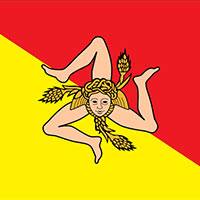Beautiful Taormina, Sicily
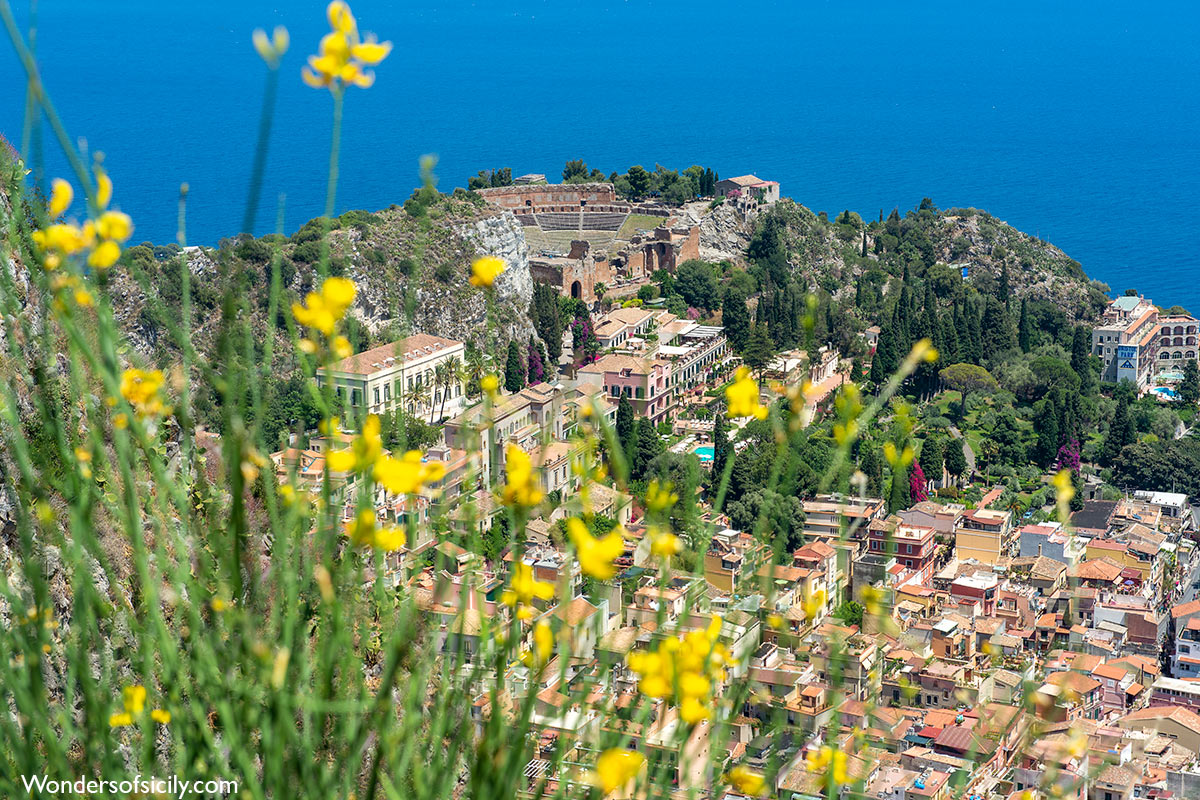
Were a man to spend only one day in Sicily and ask, "What must one see?" I would answer him without hesitation, "Taormina." (Guy de Maupassant)
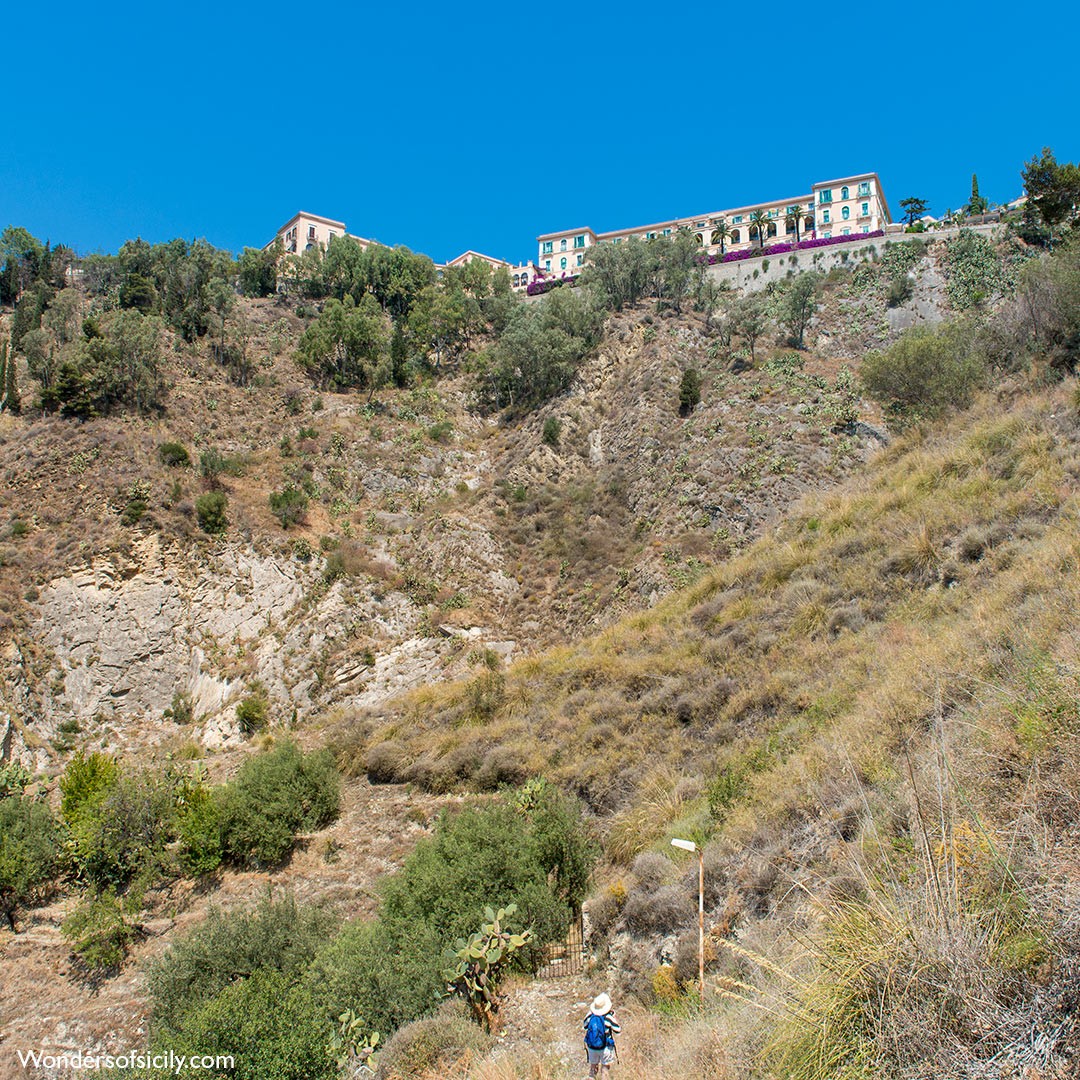
San Domenico Palace Hotel is the main Sicilian location in the critically acclaimed HBO series The White Lotus season 2.
Tauromenion for the Greeks - Tauromenium for the Romans.
The first presence of Greeks in Sicily came with the foundation of Naxos in c. 734 B.C. The settlers were Chalcidians of Euboea, Greece, under the leadership of Theocles. The Greek "invasion" of Sicily went on the next 150 years. In 403 BC Naxos was destroyed by the tyrant Dionysius of Syracuse.
Taormina was founded by the Carthaginian Himilco (after 398 BC); he populated the place with Sicels who lived in Naxos (granted them in 404 by Dionysius). In 392 BC, Taormina was captured and repopulated by Dionysius of Syracuse, who began the process of turning it into a Greek city. (Carratelli p 171)
Taormina was enlarged in 358 under Andromachus, father of the historian Timaeus, who gathered together the survivors of the destruction of Naxos (in 403 BC). It was favoured by Rome during the early days of occupation, and suffered in the Servile War (135–132 BC) when the city was held by slaves for several months. The Syrian slave rebel Eunus in Enna organised a rebellion in 135 BC which led to the First Servile War. After taking over Enna, he was joined by Cleon from Agrigento to form an army some sources says consisted of 200,000 men. They took Taormina, but in 132 BC the revolt was suppressed by the Roman consul Publius Rupilius. The 15,000 slaves were thrown off the cliffs of Taormina, according to some sources; other sources say crucified.
After Ceasar's death, the entire population of Taormina (Tauromenium), was deported and others lost their Latin rights.
The Arabs took Taormina in 903 (or 902), 72 years after Palermo and Messina fell in 831.
In 965 Taormina was attacked by the Tunisian Caliph al-Muez, and the theatre was destroyed. The caliph, who later founded modern Cairo, rebuilt the town, modestly renaming it Almoezia, as it was known until Count Roger conquered it in August 1079. Here the Sicilian Parliament assembled in 1410 to choose a king on the extinction of the line of Peter of Aragon.
Famous visitors to Taormina include Johann Wolfgang von Goethe (7-9 May, 1787), Guy de Maupassant, Richard Wagner (1882), John Dryden (1701), Kaiser Wilhelm II (1896, 1904, 1905), Edward VII (1906), George V (1924). King Gustav of Sweden regularly visited Taormina in the winter season in the ’50s and ’60s. Other famous visitors include Truman Capote, Cecil Beaton, Jean Cocteau, Osbert Sitwell, Salvador Dalí, Winston Churchill, Sibelius, Orson Welles, John Steinbeck, Tennessee Williams, Rita Hayworth, Marlene Dietrich, Greta Garbo, Cary Grant, Elizabeth Taylor and Richard Burton.The photographer Baron Wilhelm von Gloeden lived and worked in Taormina from 1896 to 1931. His speciality was homo-erotic photos. D.H. Lawrence and his wife Frieda lived here from 1920–23.
The last part of Antonioni's classic movie L'Avventura takes place in Taormina.
Sources: The Greek World (ed. G.P. Carratelli); J.F. Privitera. Sicily: An Illustrated History; The Blue Guide Sicily, Goethe: Italian Journey, Wagneropera.net

The wedding photographer in Taormina.
See wedding photos from Sicily here!
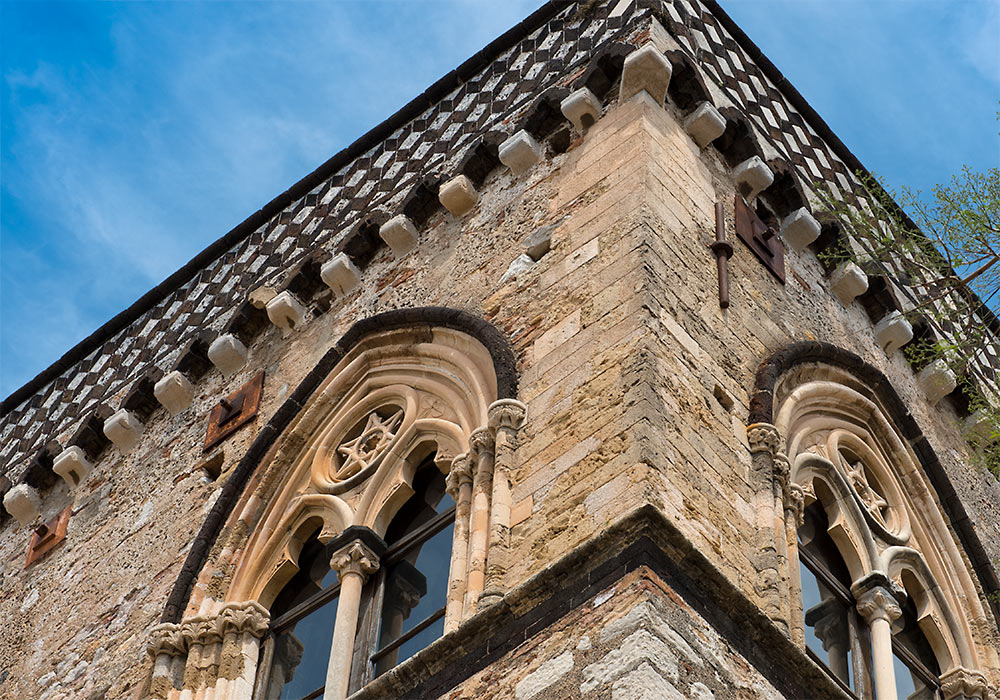
Palazzo Duchi di Santo Stefano (14th-15th century).
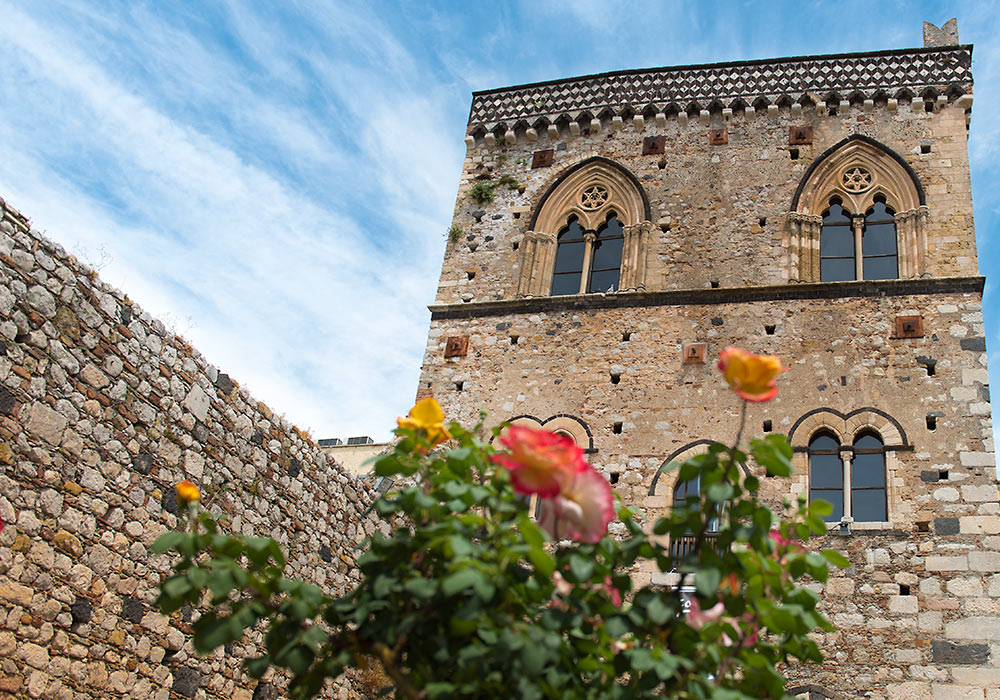
Palazzo Duchi di Santo Stefano (14th-15th century) with its beautiful stonework contrasting white and black. The palace is situated by Porta Catania, on the west side of Corso Umberto.
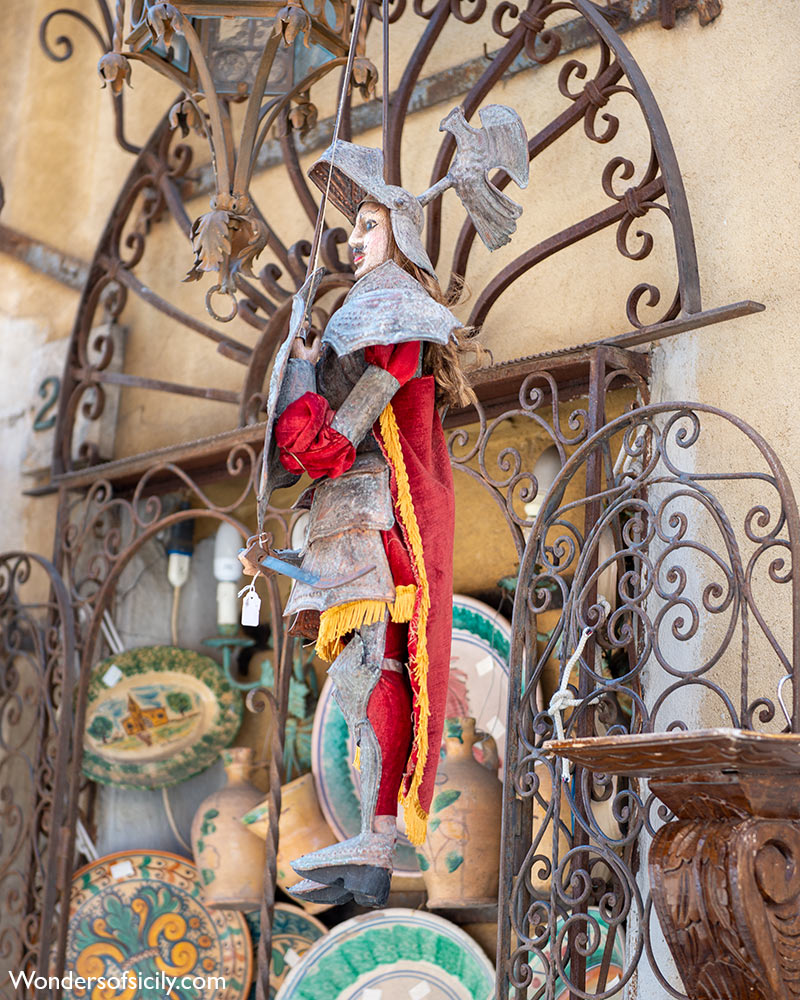
Marionette warrior.
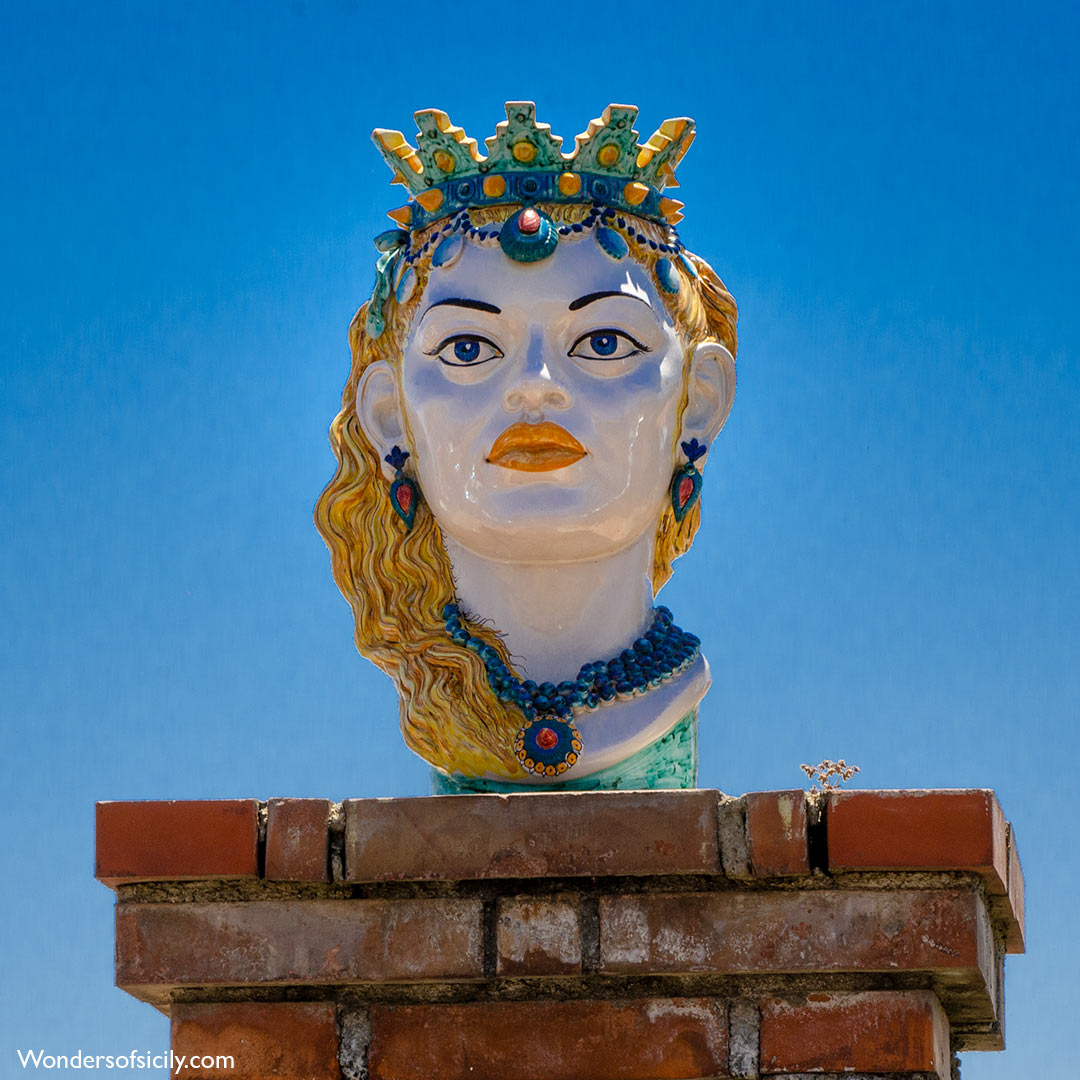
The testa di moro is a ceramic vase decorated and modeled in the shape of a head and with a human face. They are often produced in pairs, with one face of a woman and one of a man, which traditionally depicts a Moor.
The vases are widely used in Sicily to decorate balconies. The towns of Caltagirone and Santo Stefano di Camastra are known for the production of ceramics.
The name of these vases comes from the stories that revolve around them, always set in Sicily. The protagonists are a Sicilian girl and a Moor.
One of the stories tells that an Arab soldier on duty in Palermo around the year one thousand saw a beautiful girl on one of the balconies in the Kalsa district and fell in love with her. The girl returned her love and a passionate romance was born. Unfortunately the young soldier did not tell the poor girl that he had a wife and children in her homeland. Learning the truth, the Sicilian woman became furious and decapitated the soldier, and made a vase of his head.
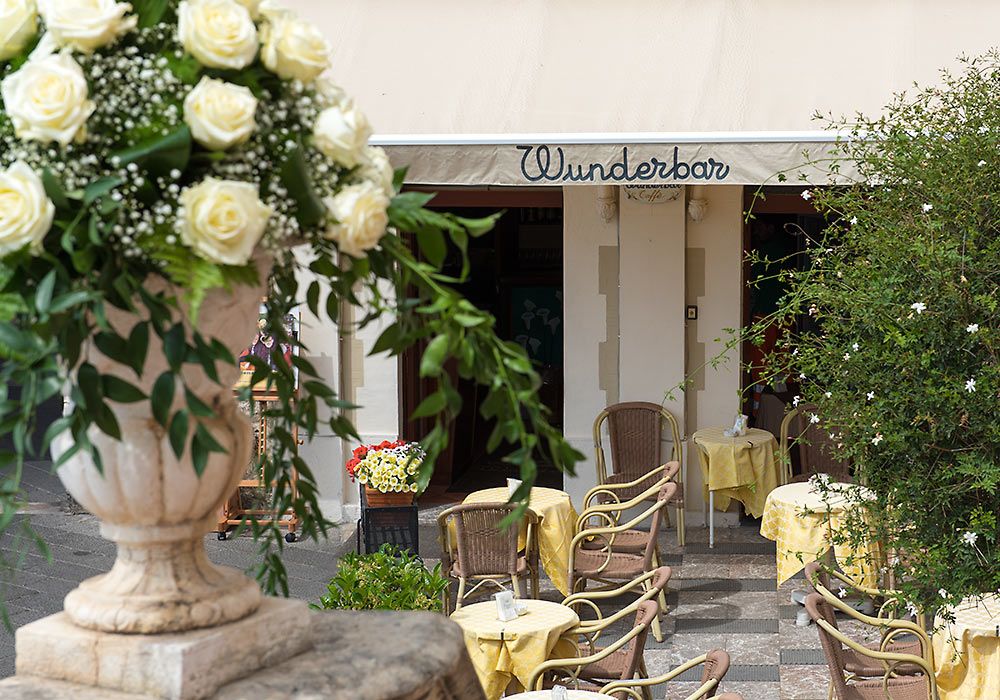
All the celebrities have been there - have you? After a visit at the Wunderbar Café on Piazza IX Aprile (on Corso Umberto I) in Taormina, you might want to check what's left of your travel budget for the day.
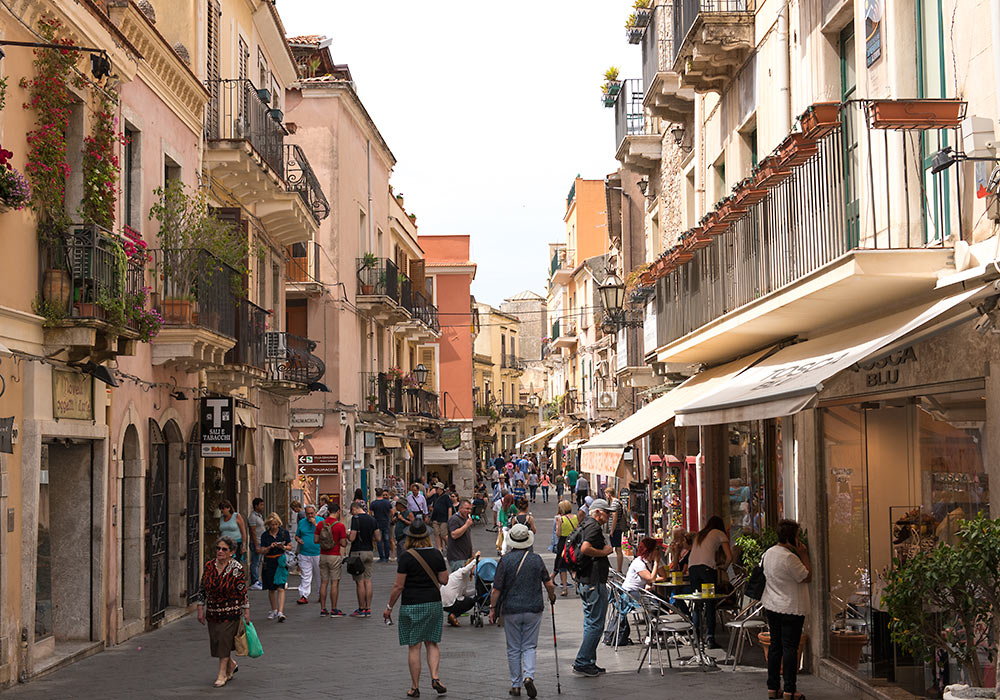
Corso Umberto I is the main street in Taormina. During the summer months it is packed with tourists.
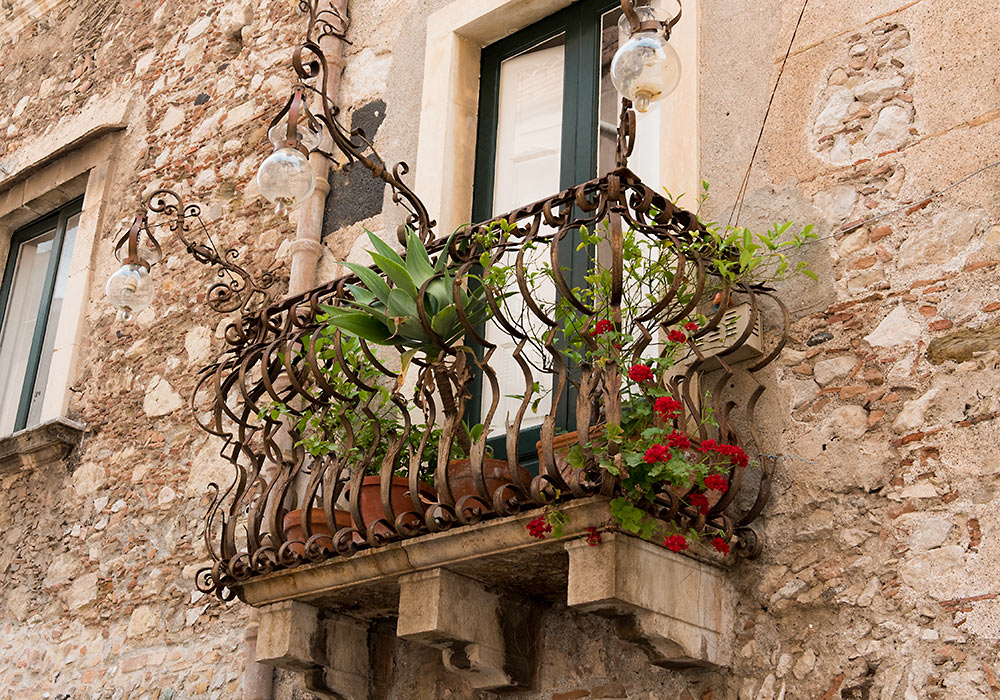
Look up when you walk down Corso Umberto I and you will see many exciting balconies.
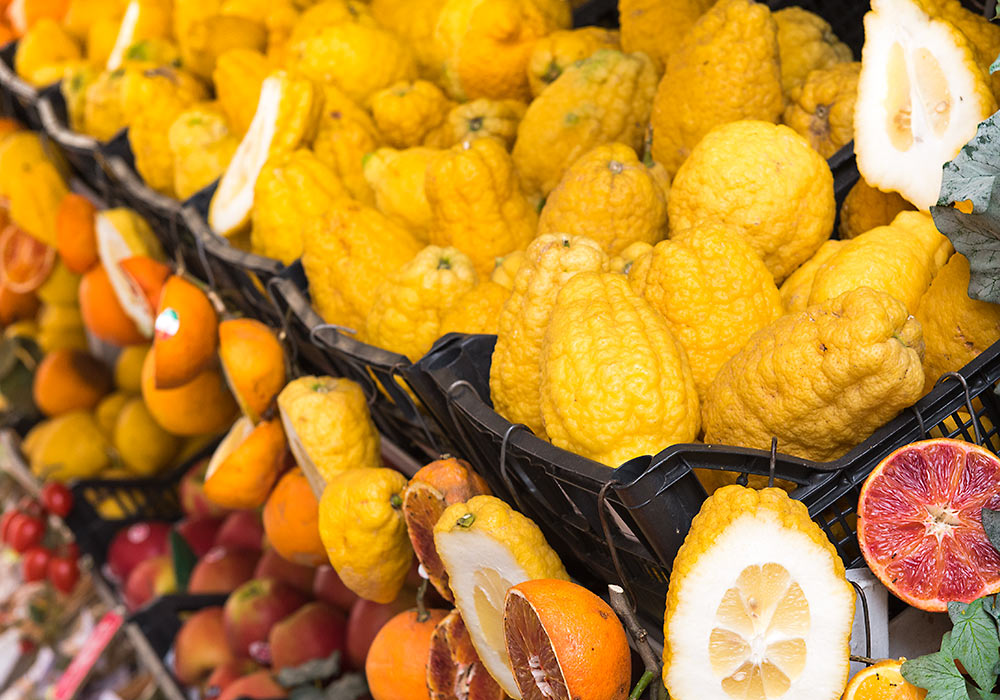
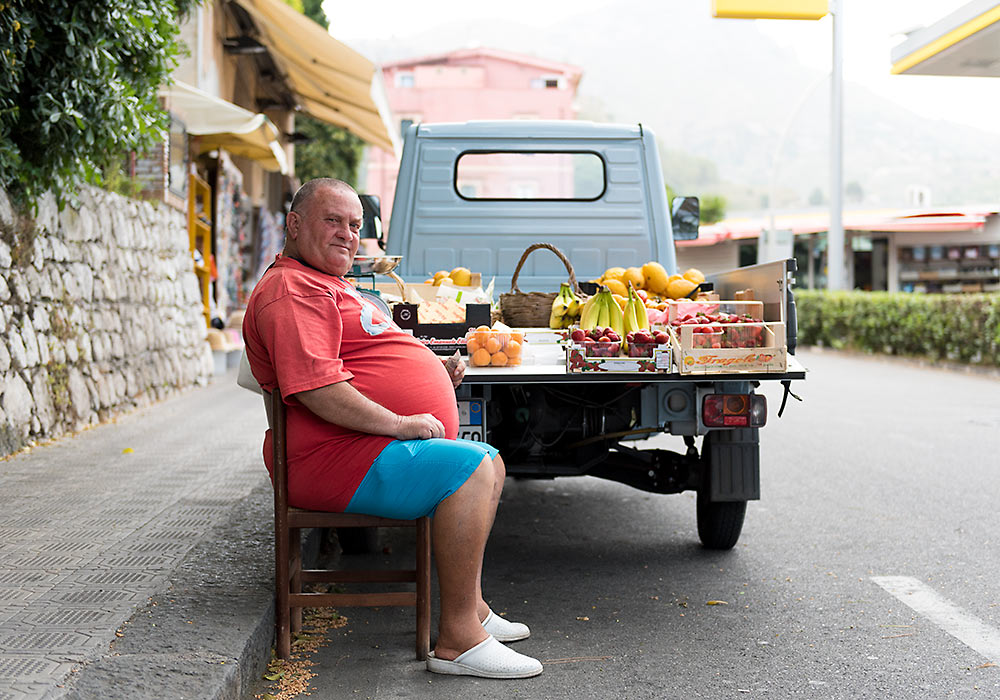
A fruit vendor in Via Luigi Pirandello, Taormina. I had to buy a ridiculously overpriced banana before I could take the picture.
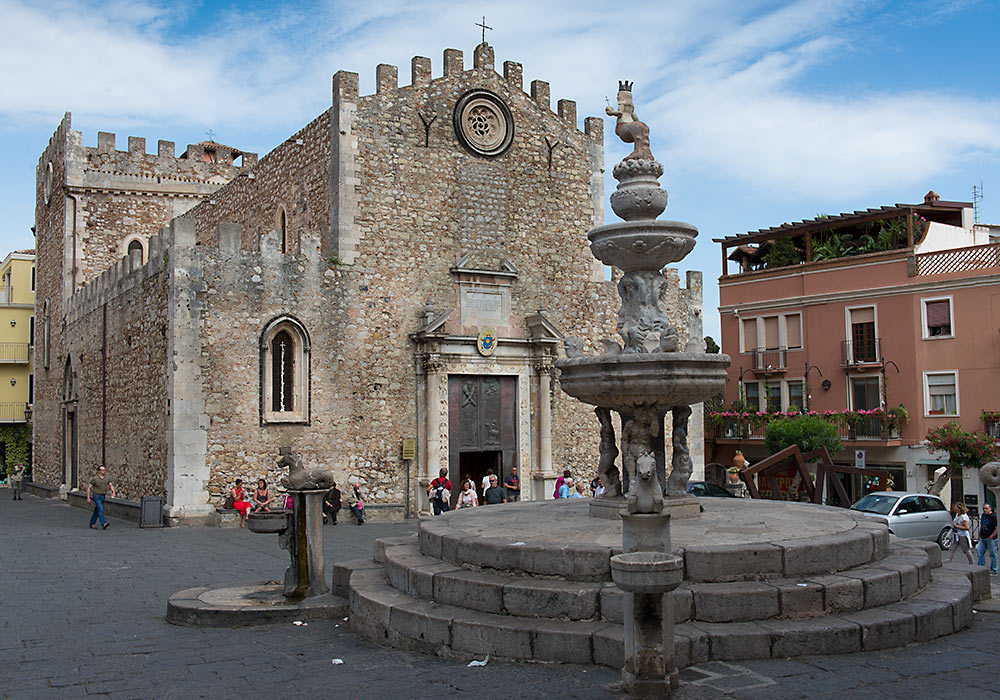
The cathedral, San Nicolò (a church dedicated to Saint Nicholas), built in the 13th century. Observe the crenelations on the roof. The portal was rebuilt in 1636. The fountain in front of the cathedral is baroque. The church occupies the area and the ruins of an earlier basilica. It was rebuilt in the 15th and 16th century and restored in the 18th century. Each doorjamb bears eleven carved figures showing some unidentified persons as well as Saint Peter with the keys of Paradise, saint Paul with the sword of Faith, king David with the cither, and the four evangelists: Saint Luke (the Bull), Saint John (the Eagle), Saint Matthew (the Angel), Saint Mark (the Lion). From 1945 to 1948, the church was fully restored by the Neapolitan architect Armando Dillon.
Photo: Per-Erik Skramstad / Wonders of Sicily
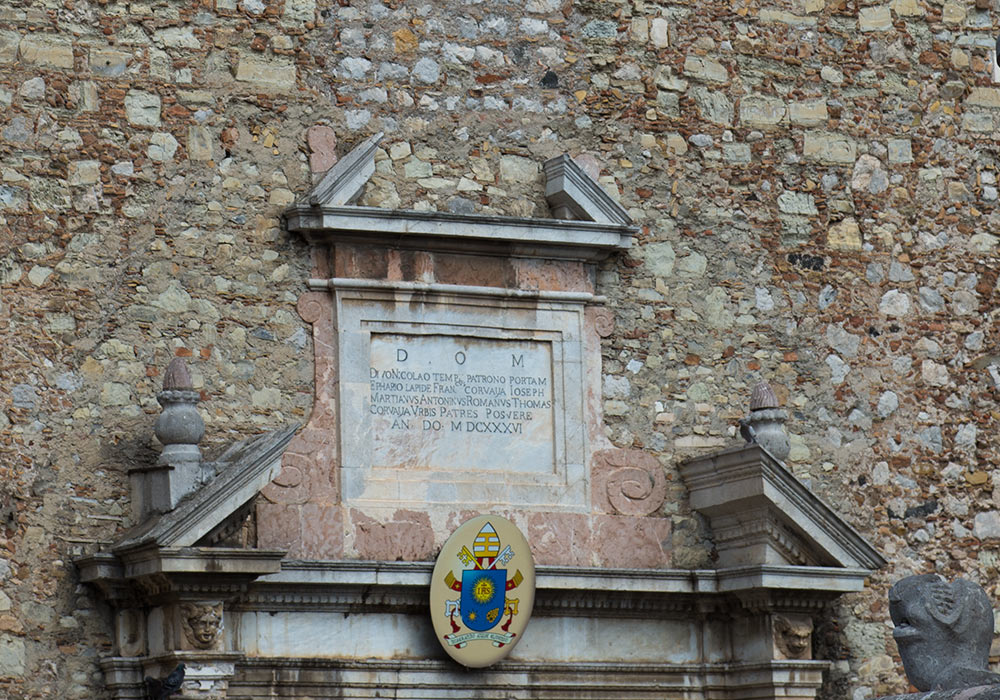
The top of the portal (1636 - MDCXXXVI) of the cathedral in Taormina with the inscription showing it was rebuilt in 1636.
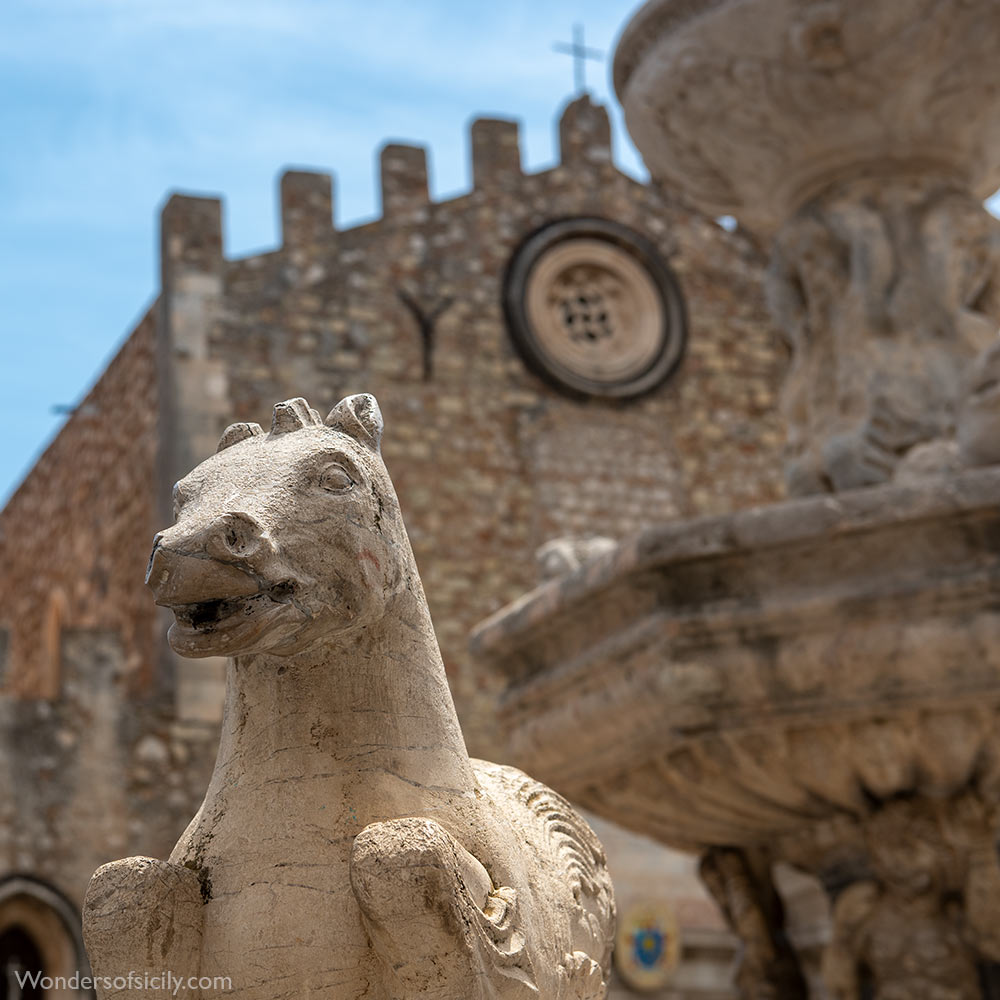
A horse on the fountain in front of the duomo.
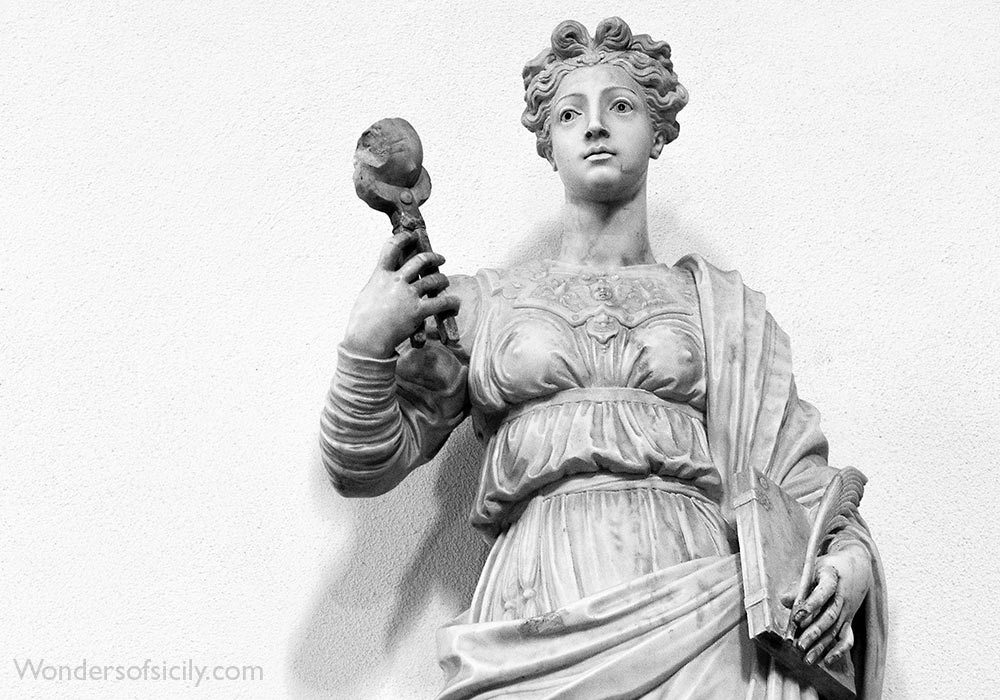
16th-century statue of St. Agatha.
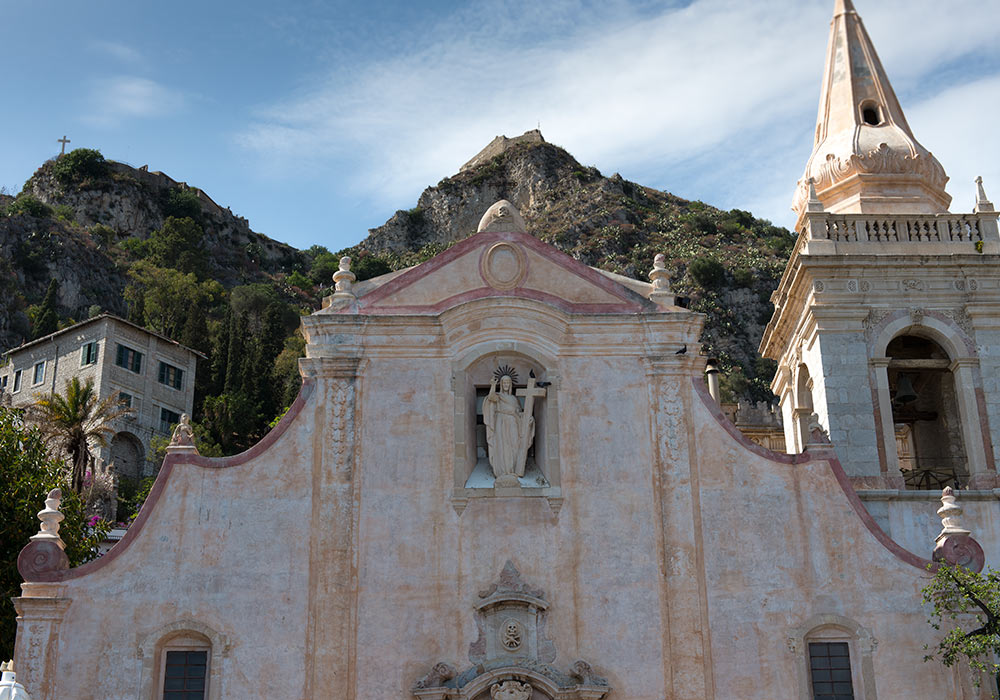
The church of San Giuseppe (piazza IX Aprile on Corso Umberto), Taormina. On top of the mountain: the Saracen castle (Castello Saraceno, now closed); to the left: the Crucifix in front of the tiny church of the Madonna della Rocca, which is carved into the rock. The crucifix was erected in 1743 by the grateful population when an epidemic of plague passed them by.
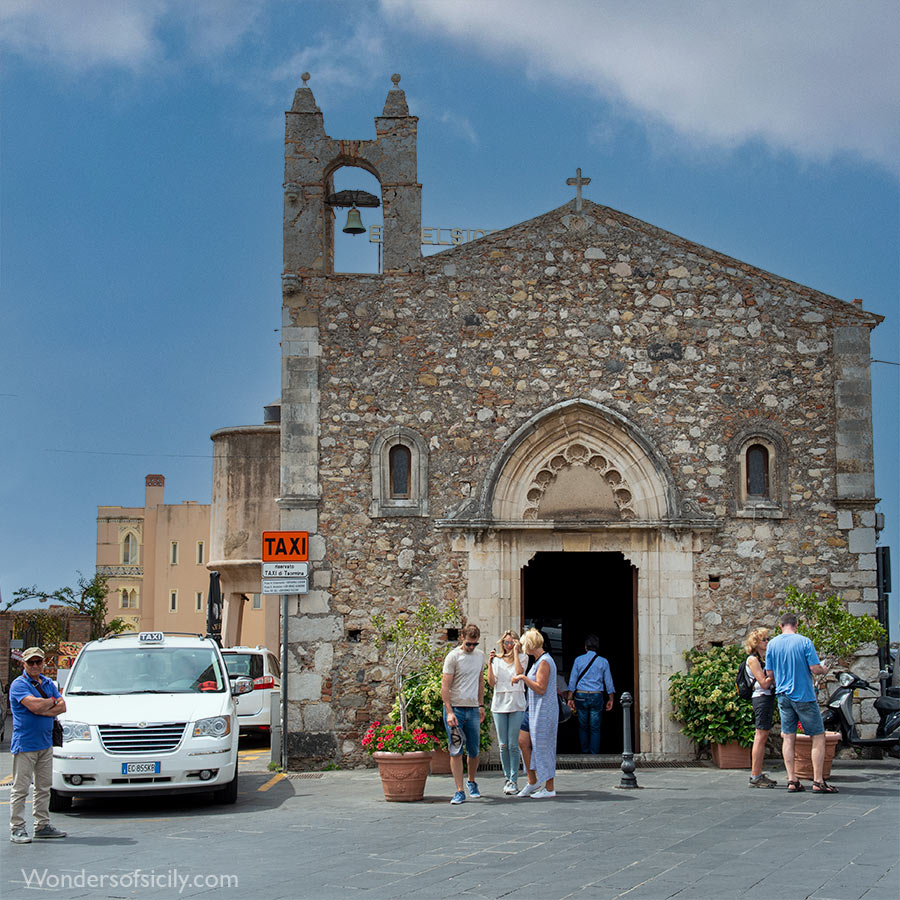
The little 14th century church of Sant'Antonio Abate is situated close to Hotel Excelsior Palace and Porta Catania. It is restored after being damaged in an air raid in 1943. The portal is Gothic.
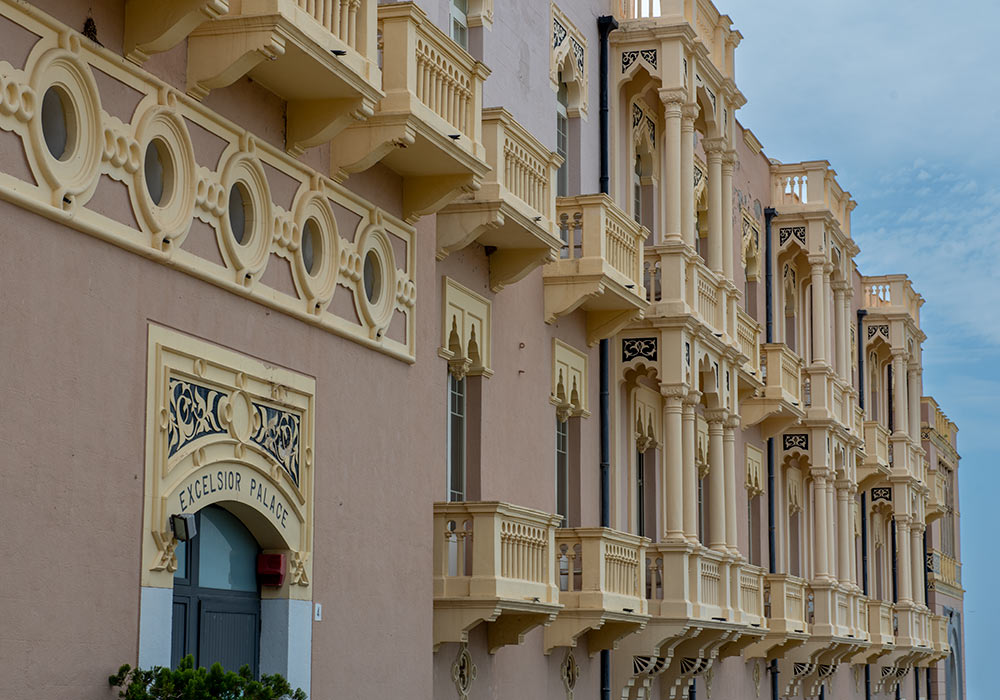
Hotel Excelsior Palace, Taormina.
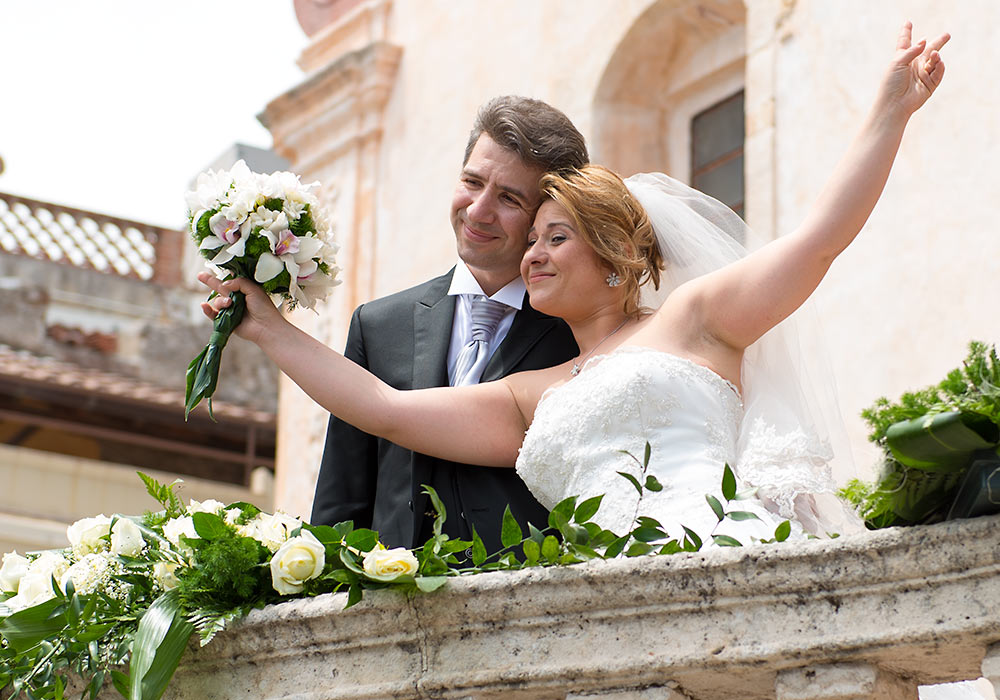
See wedding photos from Sicily here!
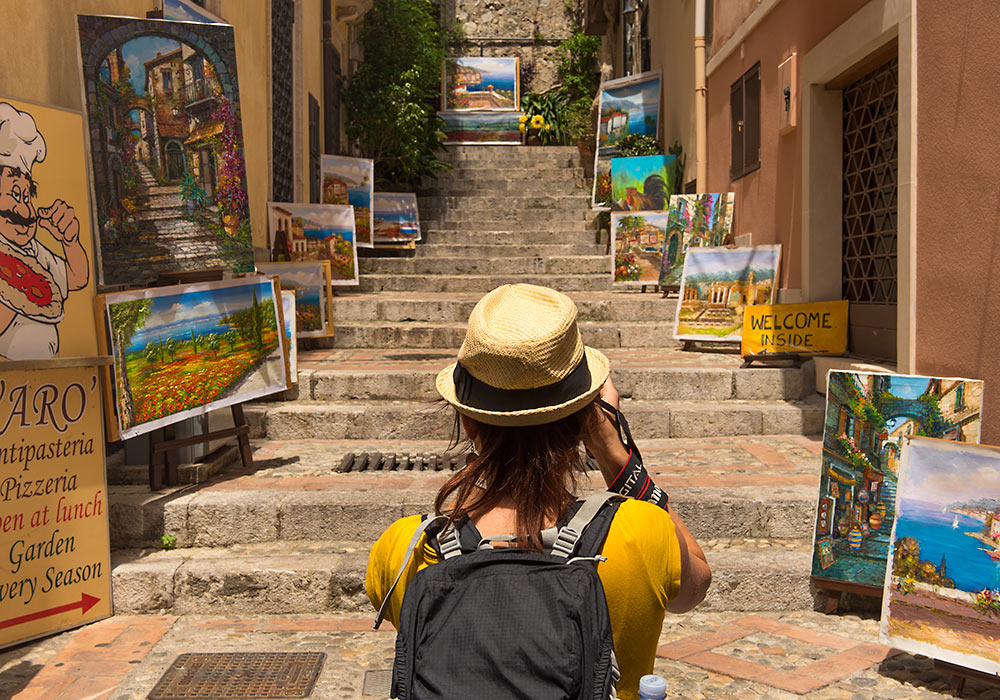
Lots of stuff to photograph in Taormina!
Sicily (1961) - British Paté
Taormina (archive footage from 1961)
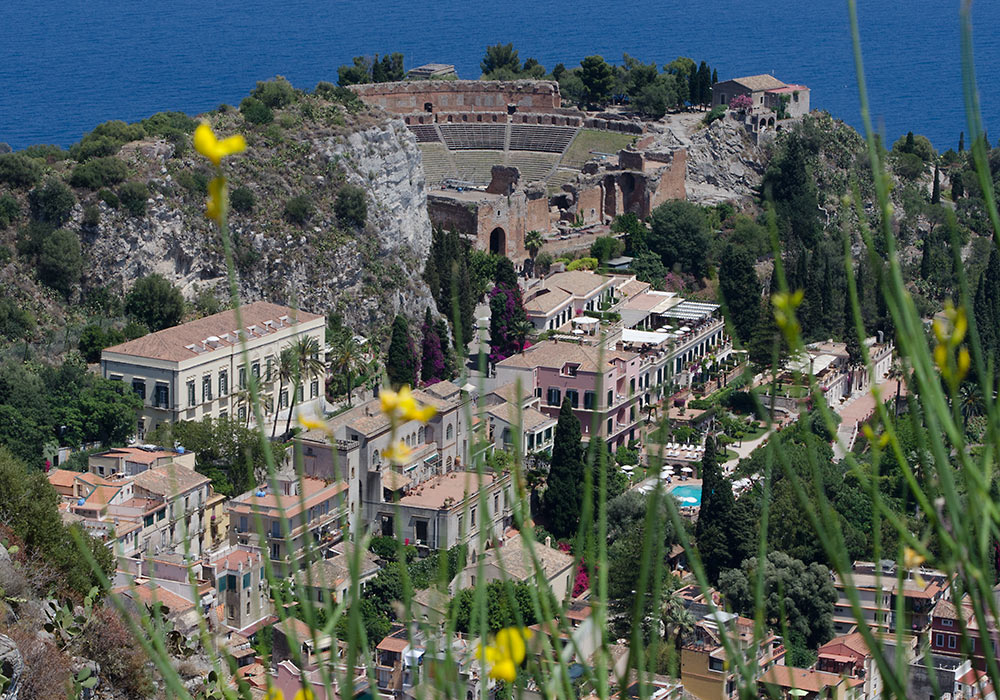
The Greek theatre in Taormina is the largest ancient theatre in Sicily after that of Syracuse. Below the mountain to the left is Hotel Timeo, the first hotel to be opened in Taormina, in 1864.
SEE MORE PHOTOS OF THE GREEK THEATRE IN TAORMINA HERE!
"Were a man to spend only one day in Sicily and ask, “What must one see?” I would answer him without hesitation, “Taormina.” It is only a landscape, but a landscape where you find everything on earth that seems made to seduce the eyes, the mind and the imagination. […] I have said, in speaking of the theater of Segesta, that the Greeks — those incomparable scenic designers — knew how to select the unique site where the theater should be built, that site made for satisfying the artistic senses. The one in Taormina is so marvellously placed that there cannot be another comparable site in the whole world."
Guy de Maupassant: Sicily
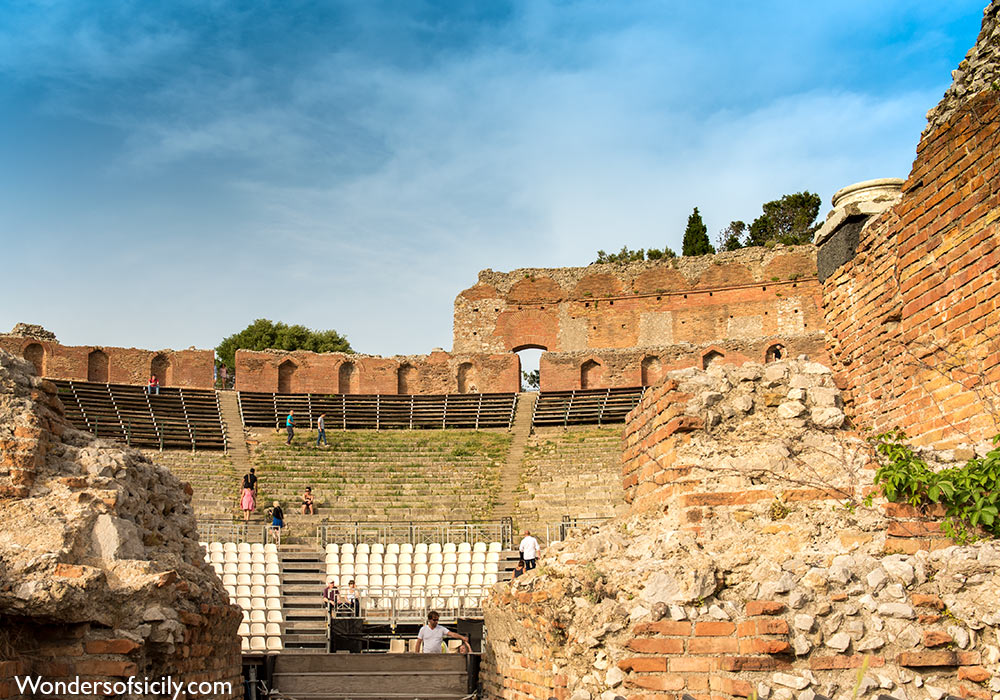
The Greek Theatre in Taormina, as seen from backstage.
Taormina grocery store
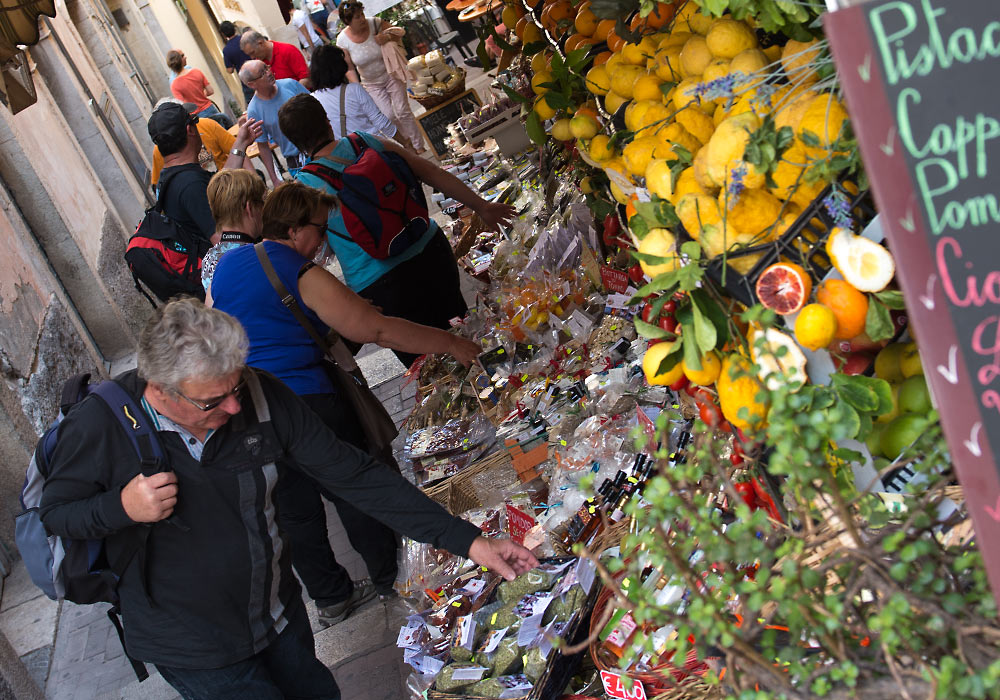
Piazza del Duomo, Taormina
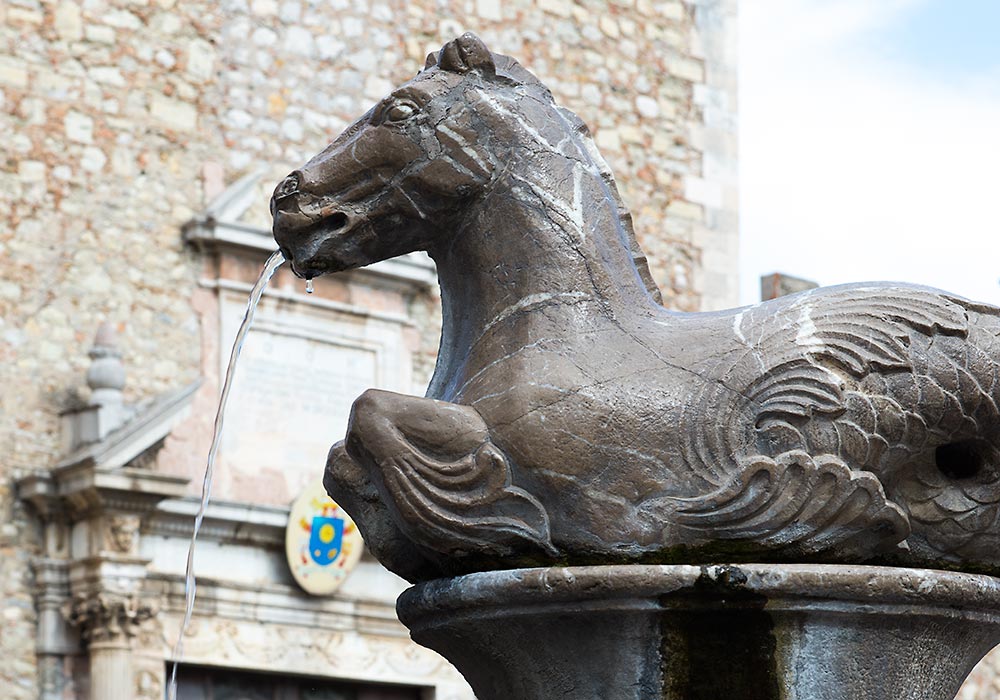
The Aragon family emblem on
Porta Catania
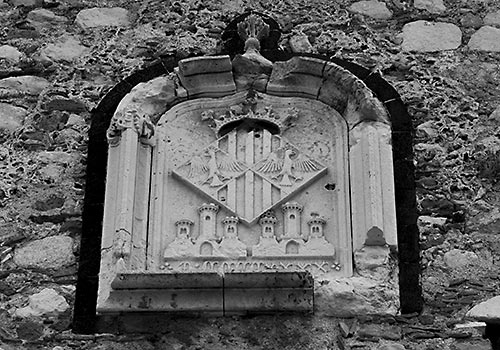
Porta Catania
aka Porta del Tocco
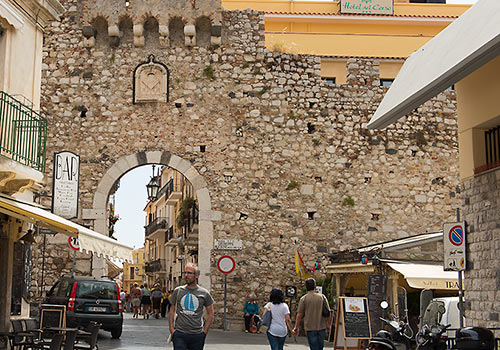
The Jewish Ghetto was located by the walls.
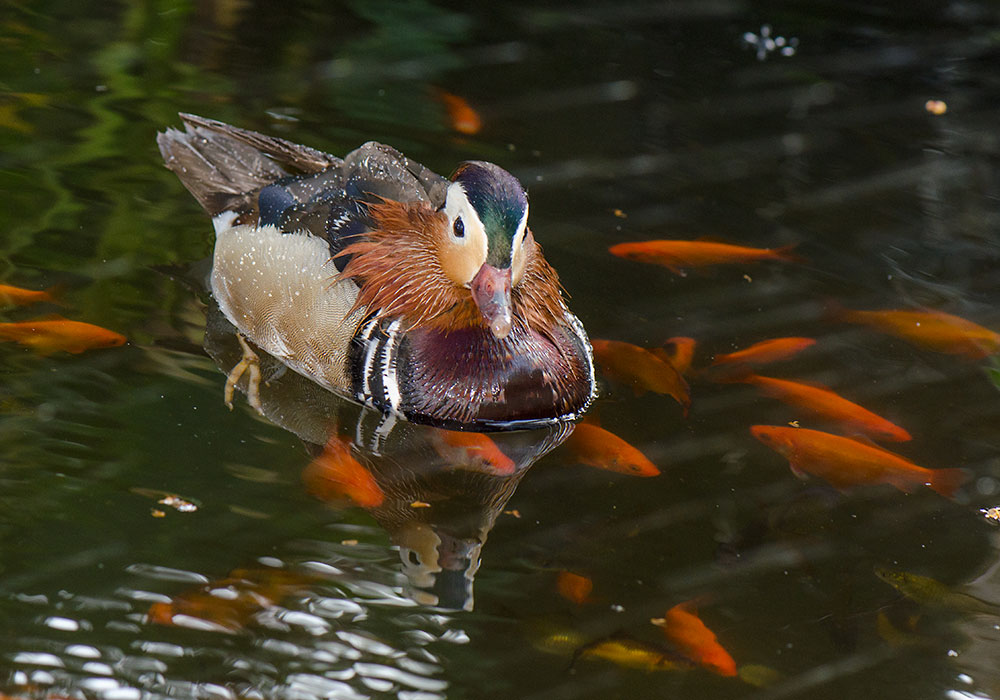
Mandarin duck in the Public Gardens, Taormina.
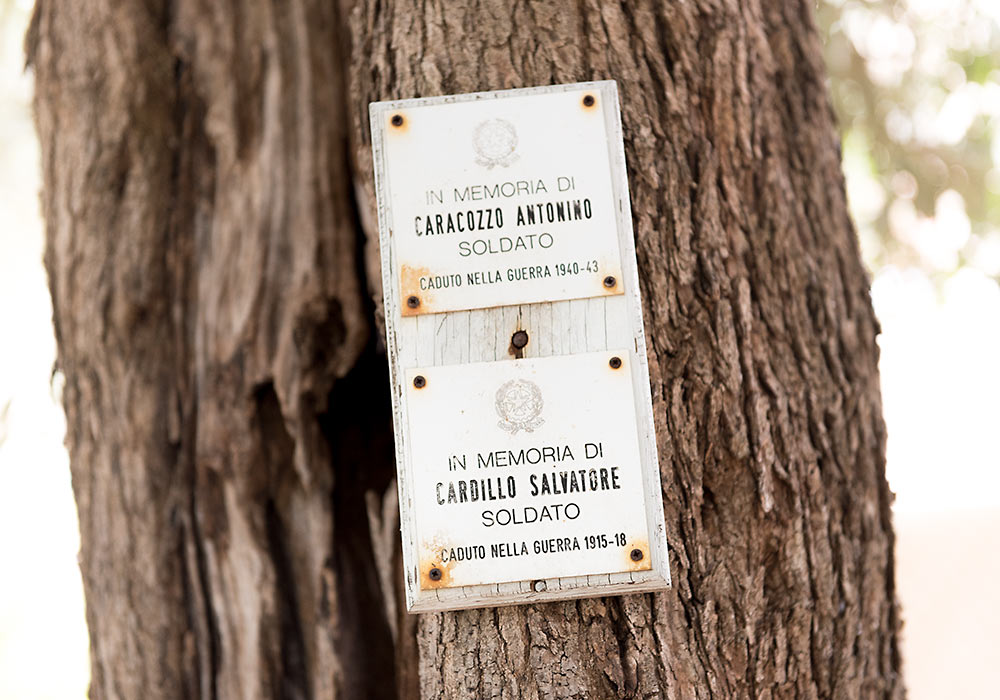
Commemorative plaques in the Public Gardens in memory of fallen Italian soldiers during WW1 and WW2.
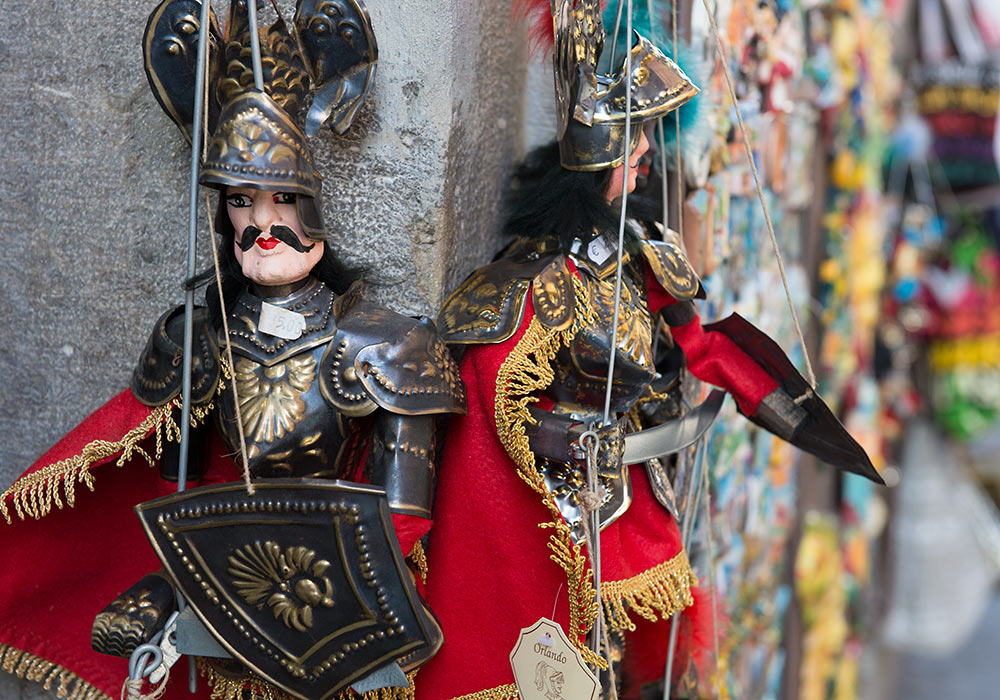
Sicilian marionettes for sale on Corso Ruggero, Taormina.
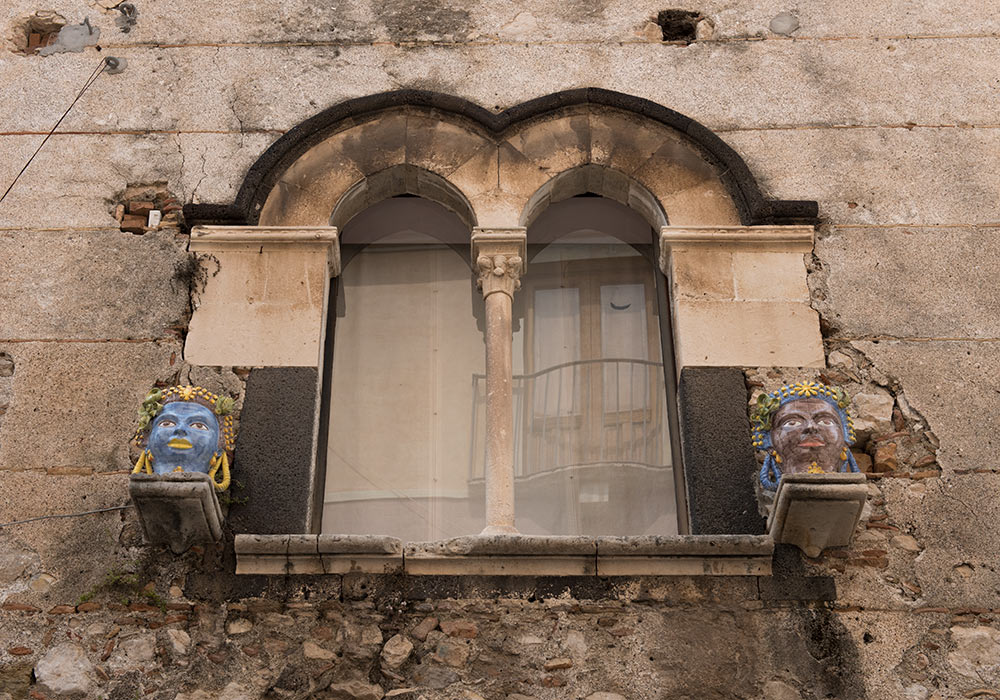
Sicilian ceramics are well known. These "teste di moro" (Moor heads), ornamental flower vases you can see everywhere in Sicily. This photo was taken in Corso Umberto, the main street in Taormina.
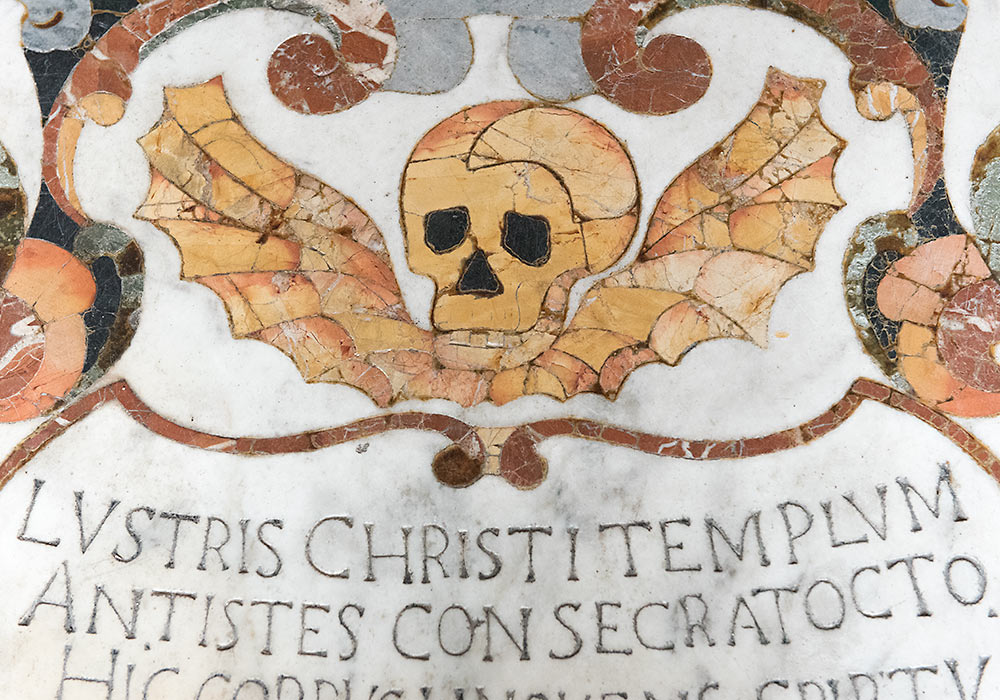
Detail of marble tomb (anno 1697) in the floor in the Church of San Pancrazio, Taormina. Saint Pancras (aka Pancratius / San Pancrazio) is the patron saint of Taormina. (Photo: Per-Erik Skramstad / Wonders of Sicily)
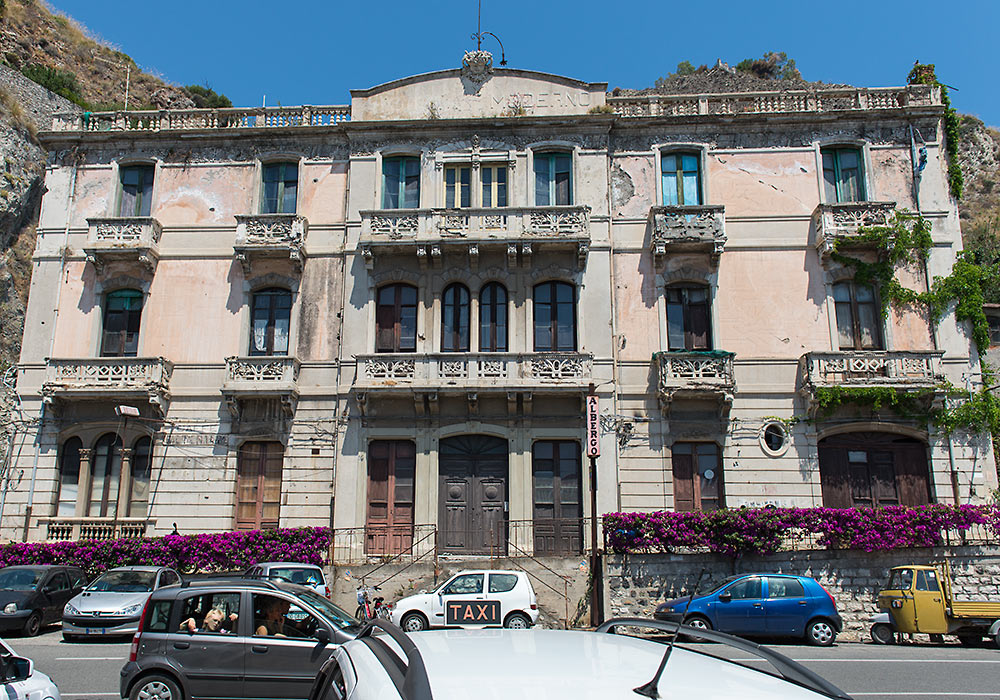
Once a hotel just opposite the railway station Taormina-Giardini - now a deserted building. I stayed there when I visited Taormina in the mid-80's!
Byzantine tomb-recesses, Via Pirandello
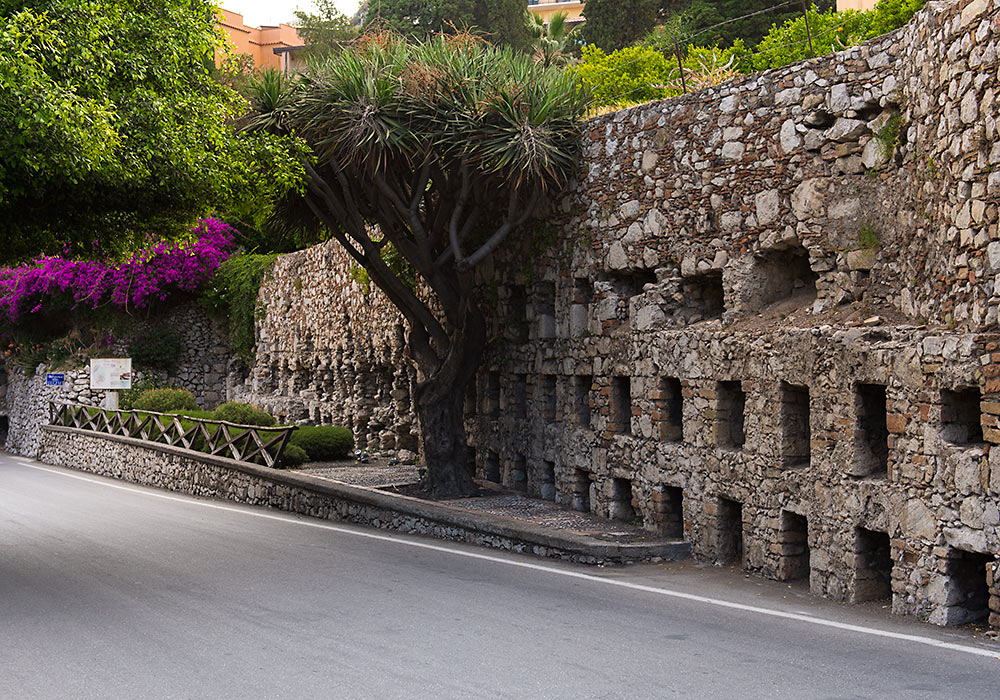
Byzantine tomb-recesses in the wall on Via Pirandello, Taormina.
- Death in Sicily
- Arcosolium, Valley of the Temples, Agrigento
- Byzantine tomb-recesses in the wall on Via Pirandello, Taormina
Cable Car: Taormina-Mazzarò
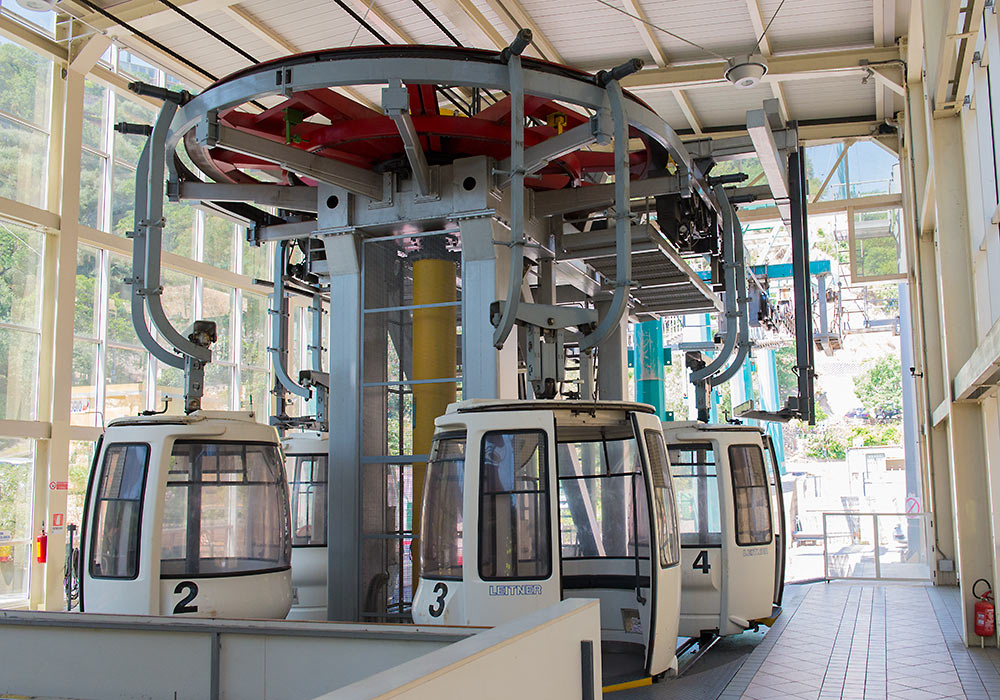
You can take the cable car from Taormina to the beach.
Photo: Per-Erik Skramstad
Hotel Villa Ducale
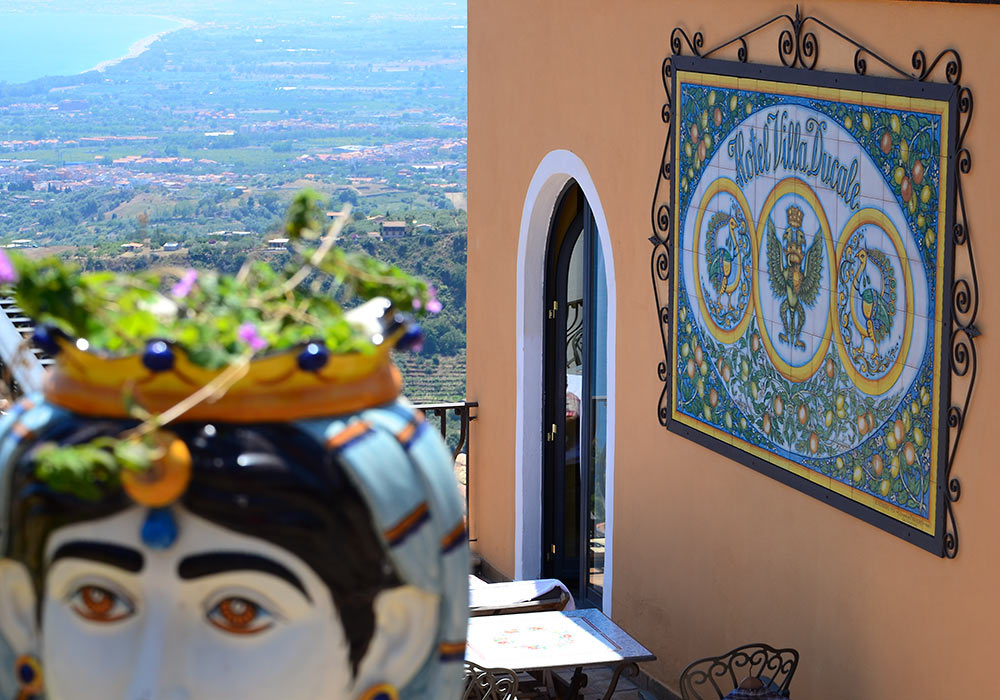
Hotel Villa Ducale, Taormina.
Photo: Torild Egge
Taormina's Public Gardens
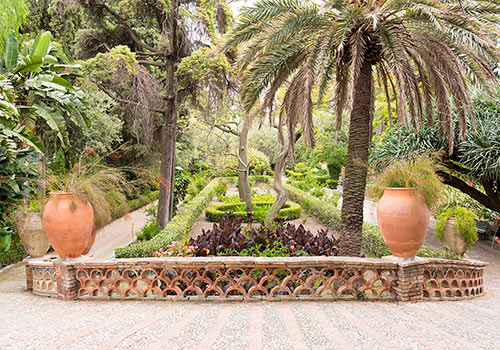
"You are my sun"
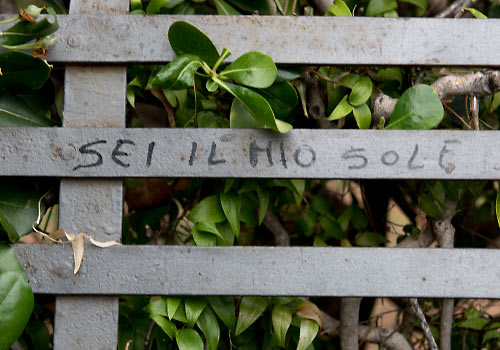
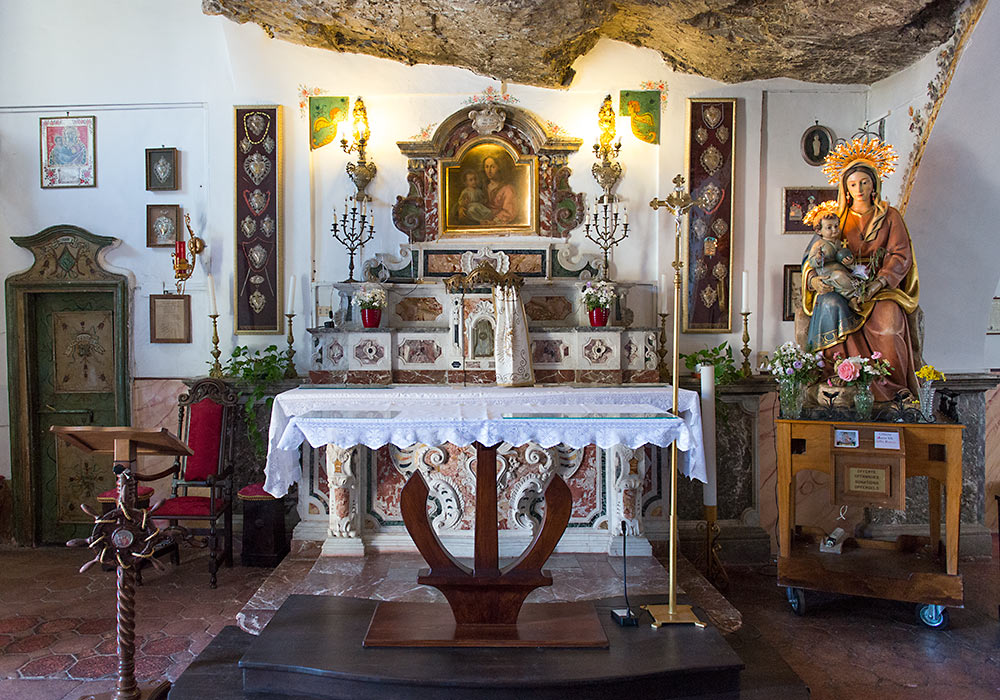
Interior of the church Madonna della Rocca, carved into the rock, above Taormina.
Photo: Per-Erik Skramstad / Wonders of Sicily
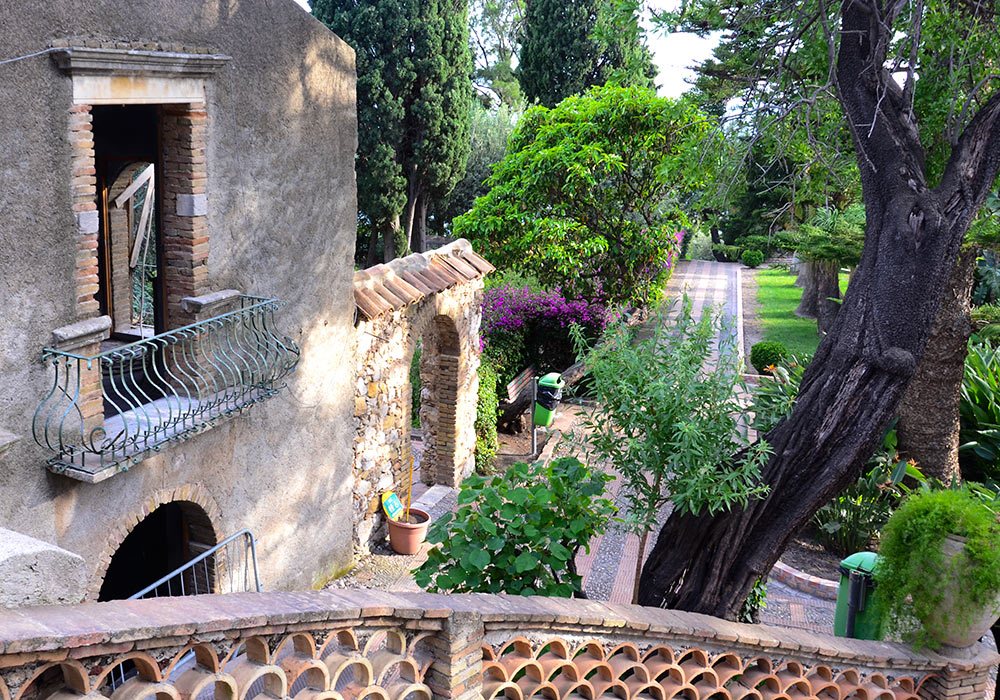
Public Garden, Taormina.
Photo: Torild Egge
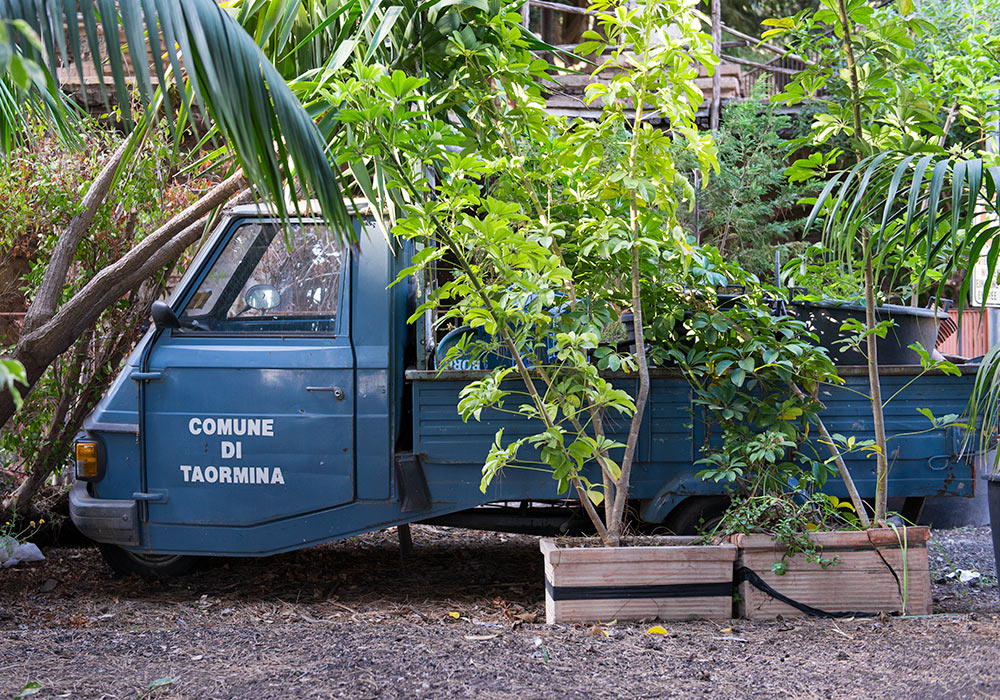
Apecar in the public garden, Taormina.
Photo: Per-Erik Skramstad / Wonders of Sicily
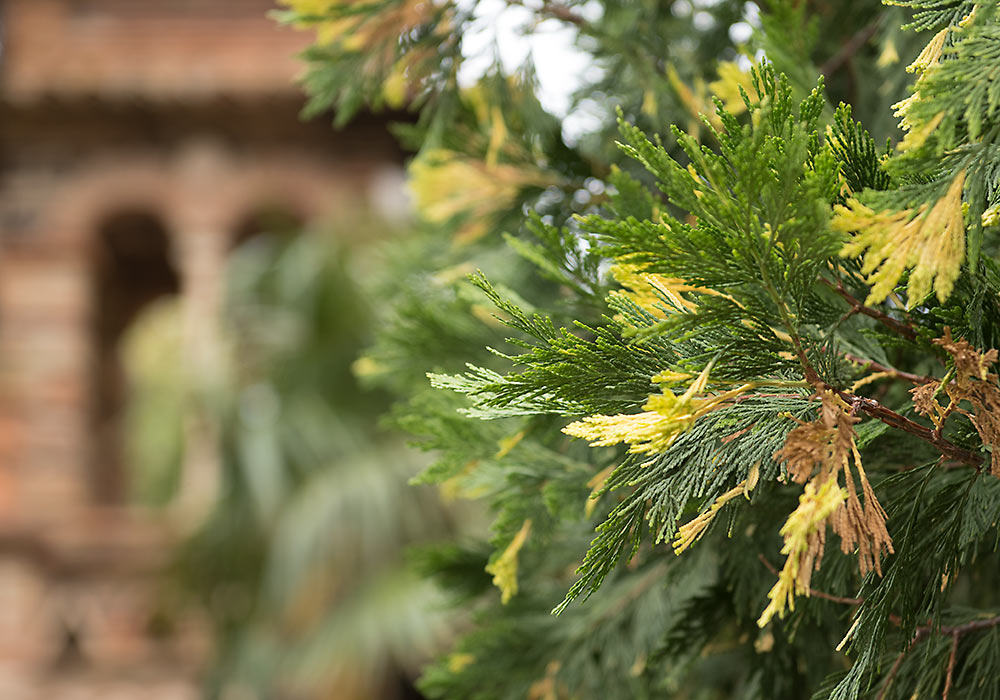
The beautiful Public Gardens is a nice place to relax when you visit Taormina.
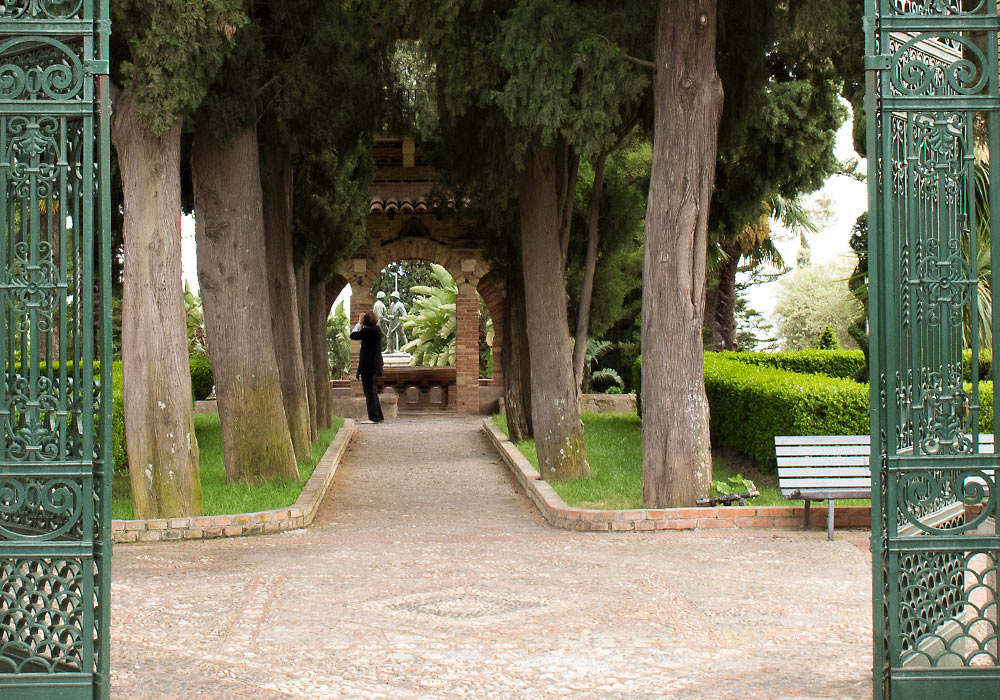
The Public Gardens. Entrance.
The Saracen Castle
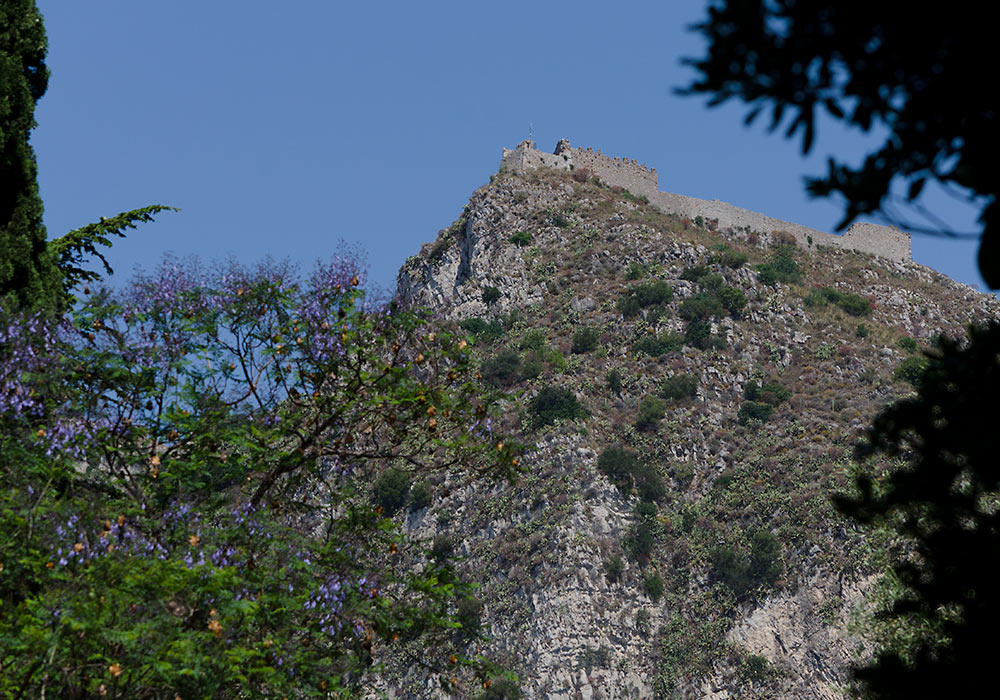
The Saracen castle (Castello Saraceno) above Taormina. In 827 the Arabs (Saracens) started a major invasion in which 10,000 men (Arabs, Berbers and Spanish Muslims) landed at Mazzara. The war with the Byzantines dragged on for fifty years. The advance of the Arabs was slow but ferocious as the most important cities were destroyed: Palermo and Messina in 831, Ragusa in 848, Syracuse in 878 and Taormina in 903.
Ibn Hamadis (c. 1090): Poem about the Norman invasion and ousting of the Arabs from Sicily
As the wolves run through the forests
so do the invaders demolish
what they find on our island
… Oh sea, why do you separate me from my homeland
… If I could only sail back to my beloved Sicily …
Ibn Hamdis (c. 1056 – c. 1133) was a Sicilian Arab poet, born in Noto, Sicily.
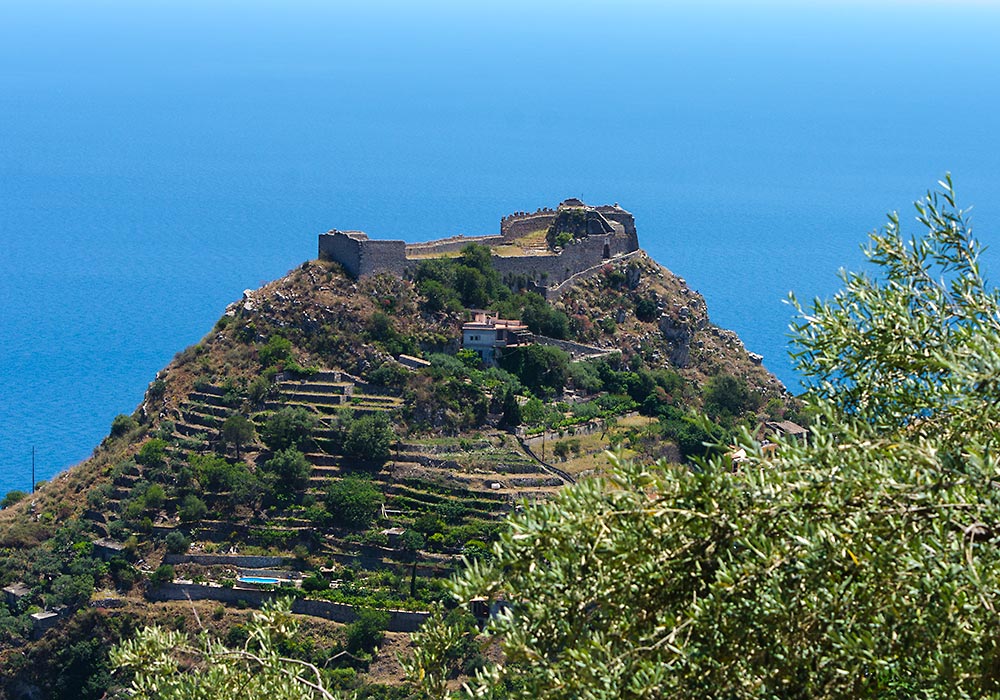
Saracen Castle (Castello Saraceno).
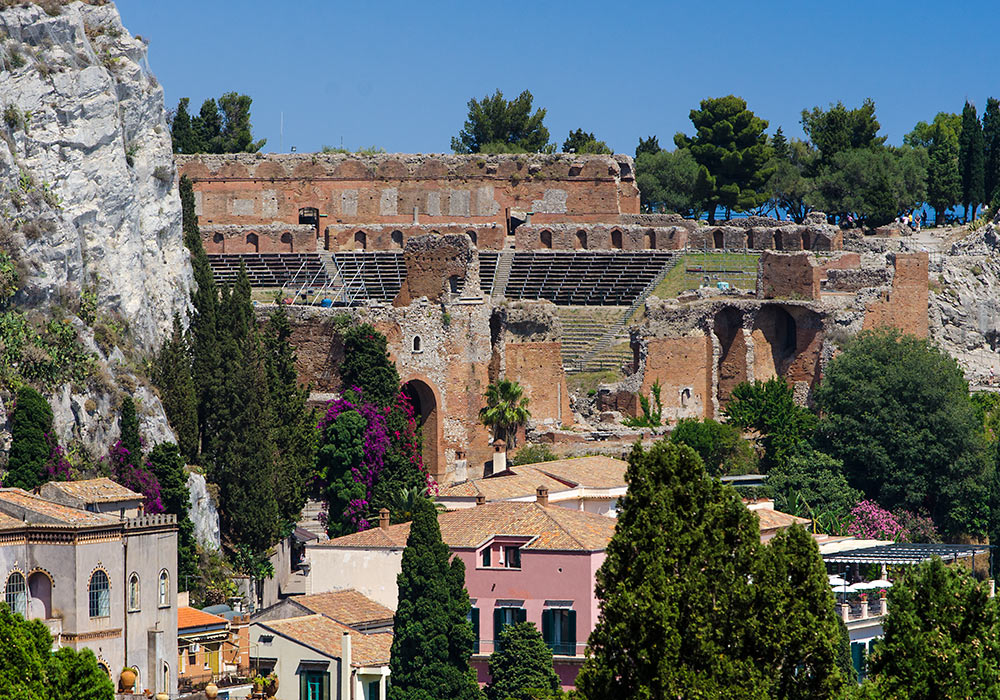
The Greek Theatre in Taormina.
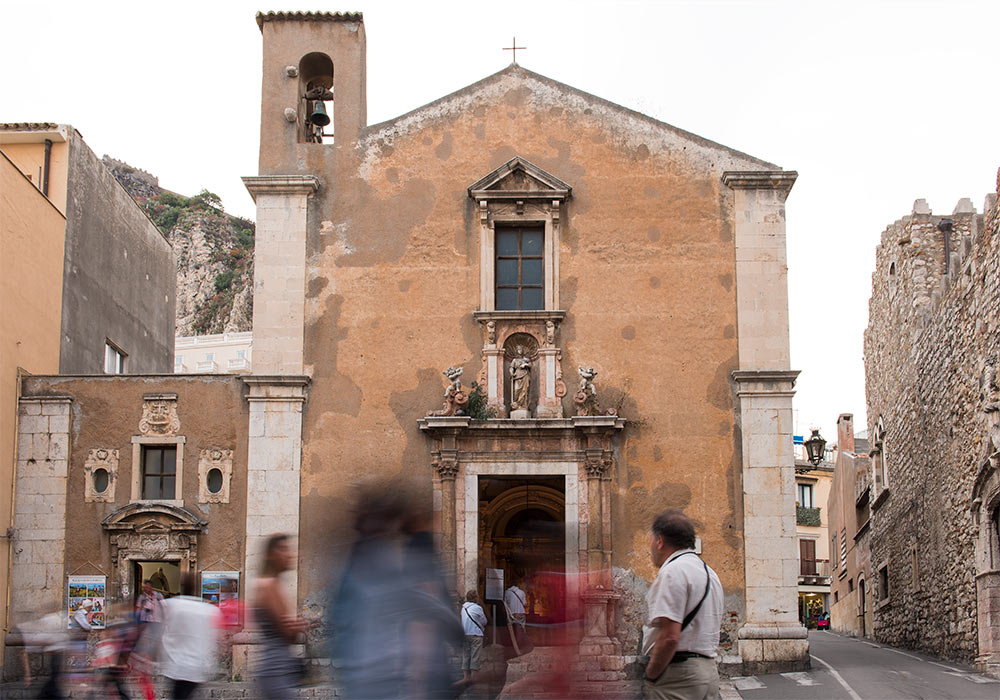
The Church of Santa Caterina (17th century). To the right, Palazzo Corvaja (early 15th century), which housed an Andy Warhol exhibition when this photo was taken (May 2015).
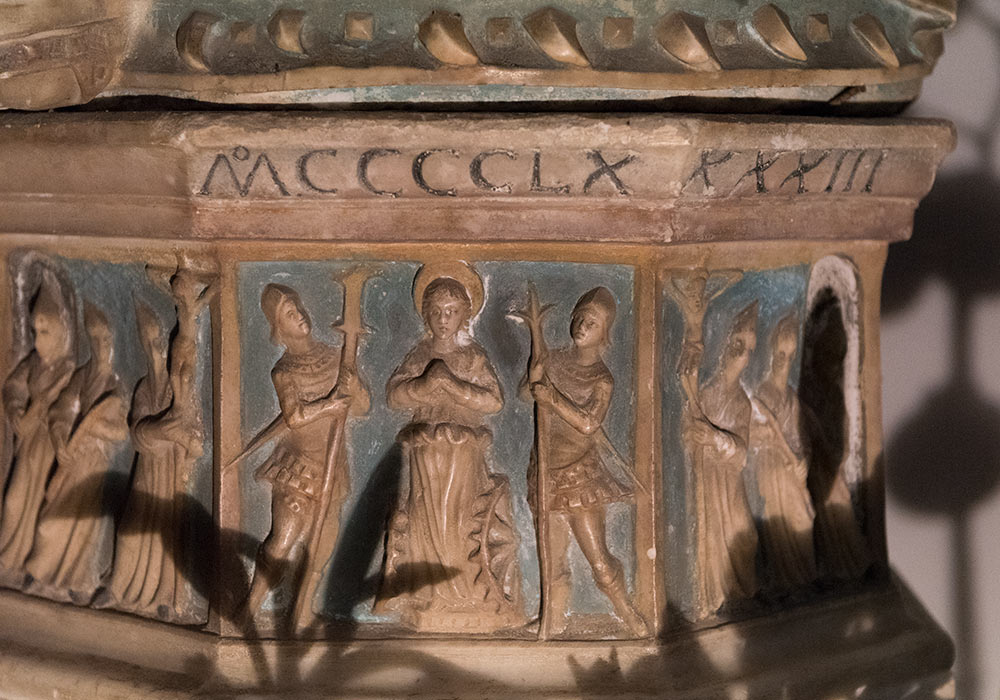
In the Church of Santa Caterina, a 15th century marble statue of St Catherine stands on a plinth (1493) with stories of her life and martyrdom.
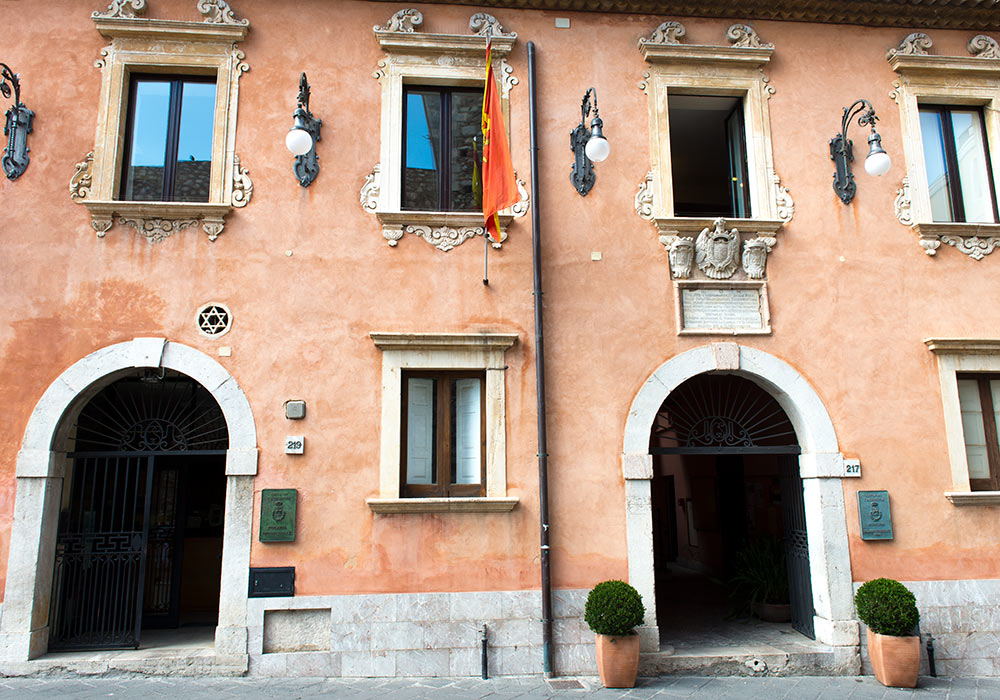
The 18th-century Municipio with the Star of David. Maybe this once was a Jewish merchant’s house.
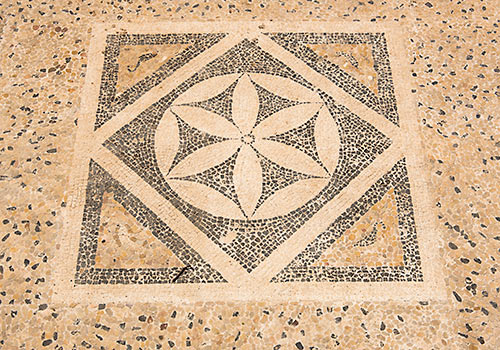
Mosaic on pavement from the Roman period, 2nd century BC. Information from Parco Archeologico di Naxos: "The pavement combines polychrome (yellow, pink, red, grey and black) cut and polished pebbles and relatively large polygonal black and white tesserae; the central geometric panes features a diamond shape inside a large square on which there is a six petaled flower om a black background. Four darting dolphins occupy the triangular shaped corners. The technique and the style date from 2nd century BC with parallels in Athens, Delos and Eretria."
Photo: Per-Erik Skramstad / Wonders of Sicily
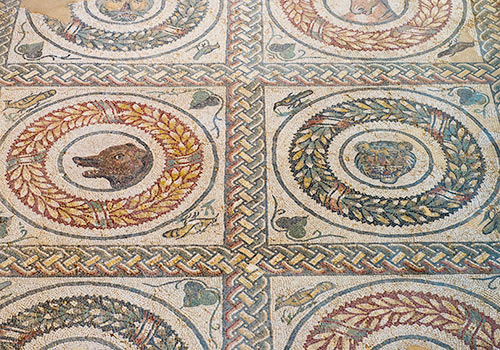
If you are interested in Roman mosaics, the fantastic museum at Villa Romana del Casale, near Piazza Armerina, is the place to go.
Photo: Per-Erik Skramstad / Wonders of Sicily
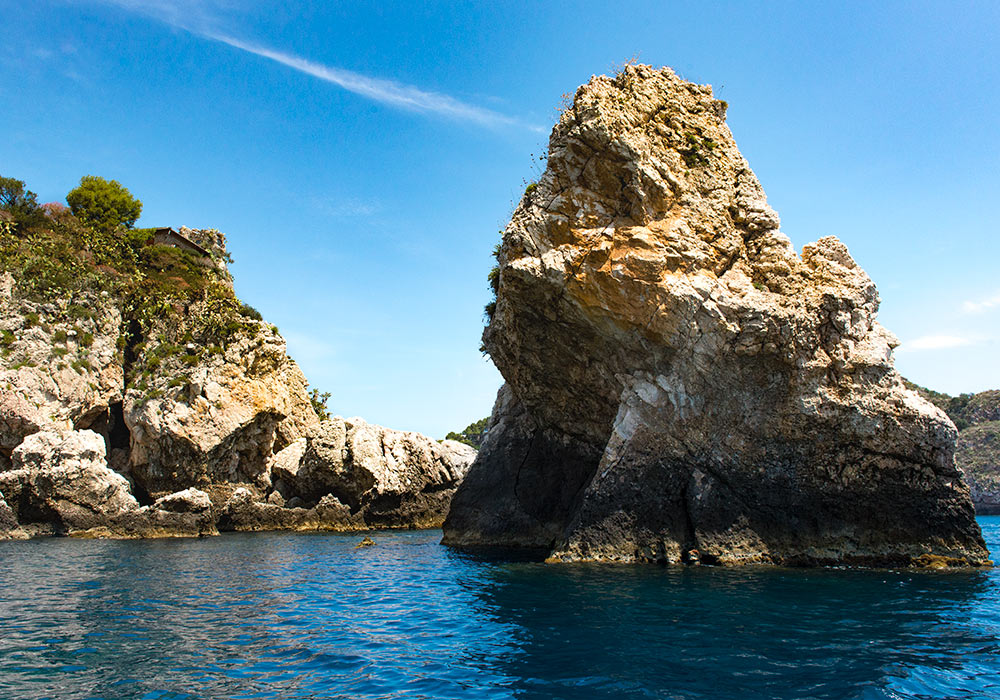
Beautiful rock formations near Isola Bella, Taormina. The photo was taken on a boat trip to a grotto nearby.
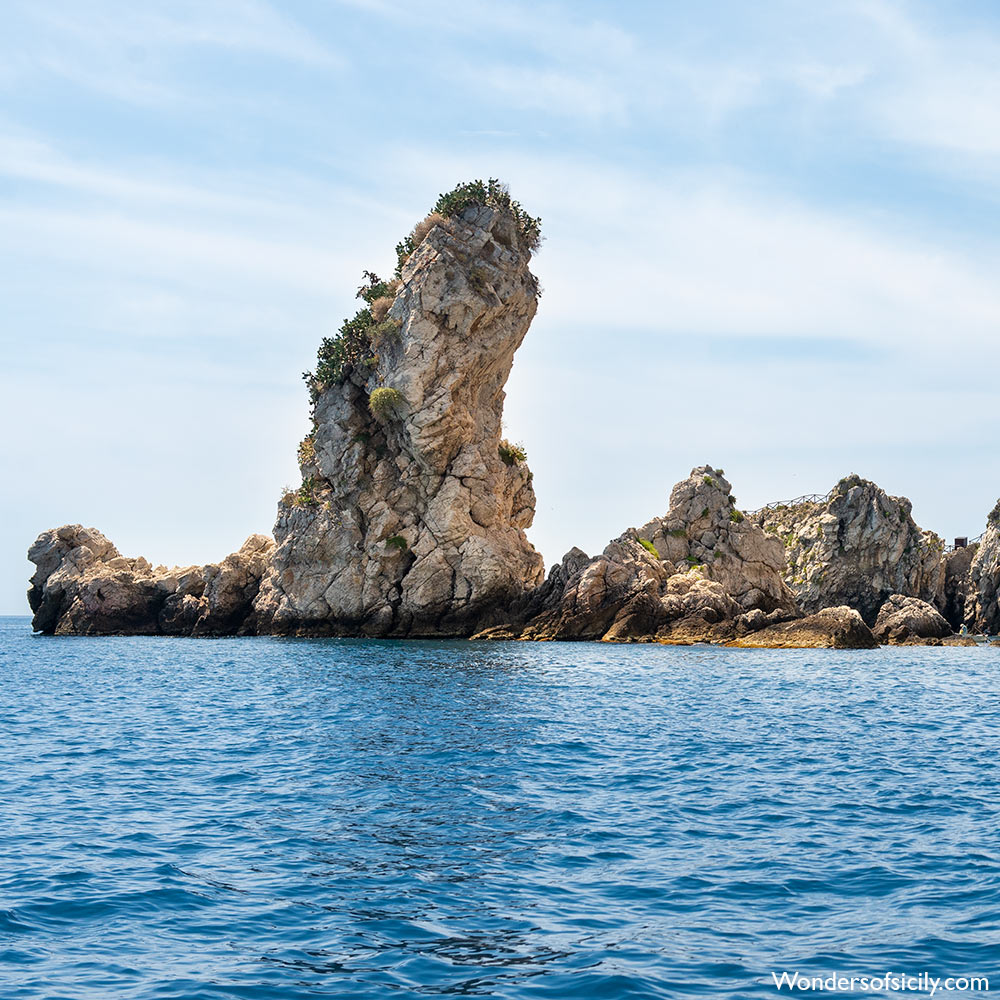
The wonderful rock formations near Taormina were used as a backdrop in several scenes in The White Lotus, season 2.
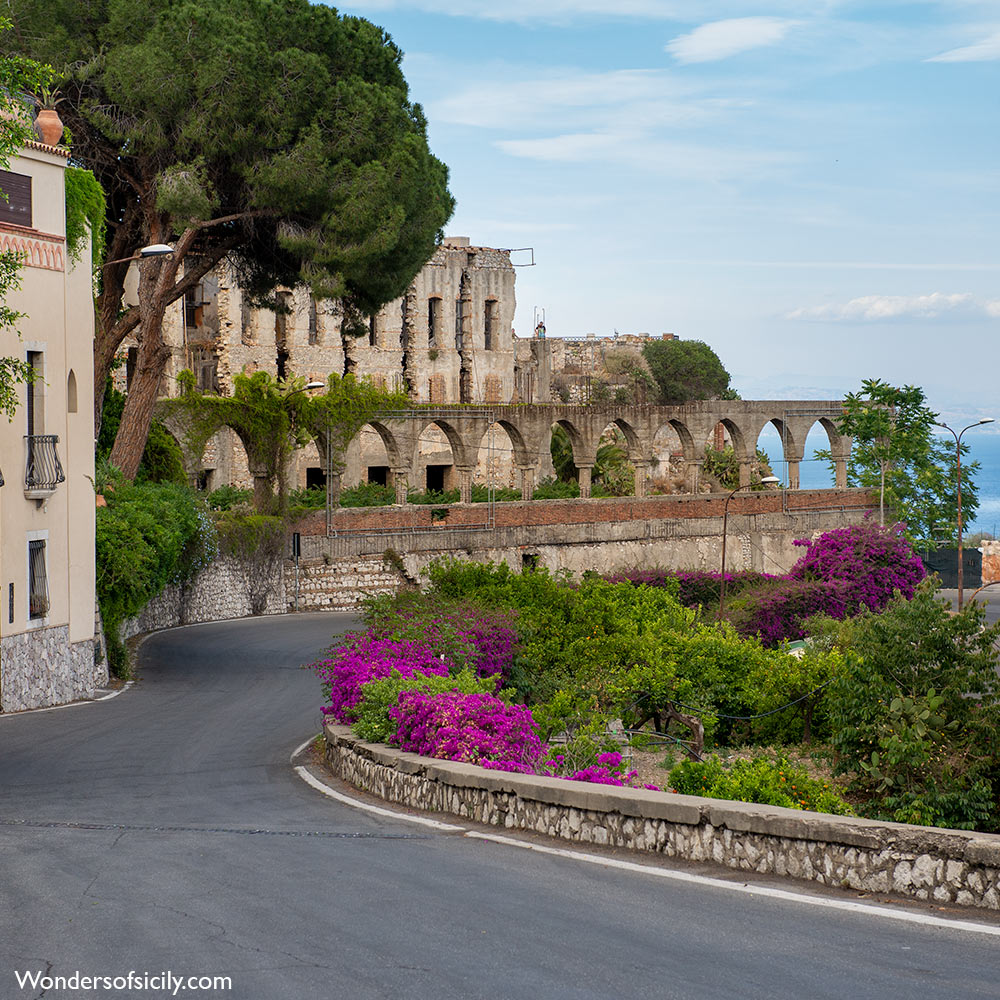
Just outside Taormina.
Read more
Sicily: Some geographical names in Italian, Sicilian, English, Latin and Greek
- Agrigento (Sicilian: Girgenti, Ancient Greek: Akragas (Ἀκράγας), Latin: Agrigentum, Arabic: Kirkent or Jirjent)
- Agrigentum, Latin for Agrigento
- Akragas (Ἀκράγας), Ancient Greek for Agrigento
- Àsaru, Sicilian for Assoro
- Assorus, Latin for Assoro
- Assoros, Greek for Assoro
- Baarìa, Sicilian for Bagheria (also the title of a film by Giuseppe Tornatore)
- Balarm, Arabic for Palermo
- Butirah, Arabic for Butera (one of the largest cities in Arab Sicily)
- Càccamu Sicilian for Caccamo
- Castrogiovanni (until 1926 Enna was known as Castrogiovanni)
- Castrugiuvanni, Sicilian for Enna
- Cefalù (Sicilian: Cifalù, Greek: Κεφαλοίδιον, Diod., Strabo, or Κεφαλοιδὶς, Ptol.; Latin: Cephaloedium, or Cephaloedis)
- Cephaloedium or Cephaloedis, Latin for Cefalù
- Cifalù, Sicilian for Cefalù
- Egesta, Greek for Segesta
- Enna (Sicilian: Castrugiuvanni; Greek: Ἔννα; Latin: Henna and less frequently Haenna). Until 1926 the town was known as Castrogiovanni.
- Girgenti, Sicilian for Agrigento
- Henna / Haenna, Latin for Enna
- Hyspicae Fundus, Latin for Ispica
- Ispica (Sicilian: Spaccafurnu, Latin: Hyspicae Fundus)
- Jirjent, Arabic for Agrigento (also: Kirkent)
- Kefaloidion or Kefaloidis (Κεφαλοίδιον / Κεφαλοιδὶς), Greek for Cefalù
- Kentoripa, ancient Greek for Centuripe
- Kirkent, Arabic for Agrigento (also: Jirjent)
- Noto (Sicilian: Notu; Latin: Netum)
- Notu, Sicilian for Noto
- Netum, Latin for Noto
- Palermo (Sicilian: Palermu, Latin: Panormus, from Greek: Πάνορμος, Panormos, Arabic: Balarm, Phoenician: Ziz)
- Palermu, Sicilian for Palermo
- Panormos (Πάνορμος), Greek for Palermo
- Panormus, Latin for Palermo (from Greek: Πάνορμος, Panormos)
- Sarausa, Sicilian for Siracusa
- Selinous, Greek for Selinunte
- Selinus, Latin for Selinunte
- Siggésta, Sicilian for Segesta
- Siracusa (English: Syracuse, Latin: Syracusæ, Ancient Greek: Syrakousai (Συράκουσαι), Medieval Greek: Συρακοῦσαι, Sicilian: Sarausa)
- Spaccafurnu, Sicilian for Ispica
- Syracuse, English for Siracusa
- Syracusæ, Latin for Siracusa
- Syrakousai (Συράκουσαι), Ancient Greek for Siracusa
- Syrakousai (Συρακοῦσαι), Medieval Greek for Siracusa
- Taormina (Sicilian: Taurmina, Greek: Ταυρομένιον Tauromenion, Latin: Tauromenium)
- Taurmina, Sicilian for Taormina
- Tauromenion (Ταυρομένιον), Greek for Taormina
- Tauromenium, Latin for Taormina
- Terranova is the old name for Gela (the fifth largest town in Sicily)
- Ziz, Phoenician for Palermo
Sources
- Joseph F. Privitera: "Sicily: An Illustrated History"
- Sandra Benjamin: Sicily: Three Thousand Years of Human History
- Jeremy Dummett: Syracuse, City of Legends: A Glory of Sicily
- Jeremy Dummett: Palermo, City of Kings: The Heart of Sicily
- The Greek World (ed. G.P. Carratelli)
- The Blue Guide Sicily
- Goethe: Italian Journey
- Wagneropera.net
- Wikipedia
- More sources and recommended reading here

